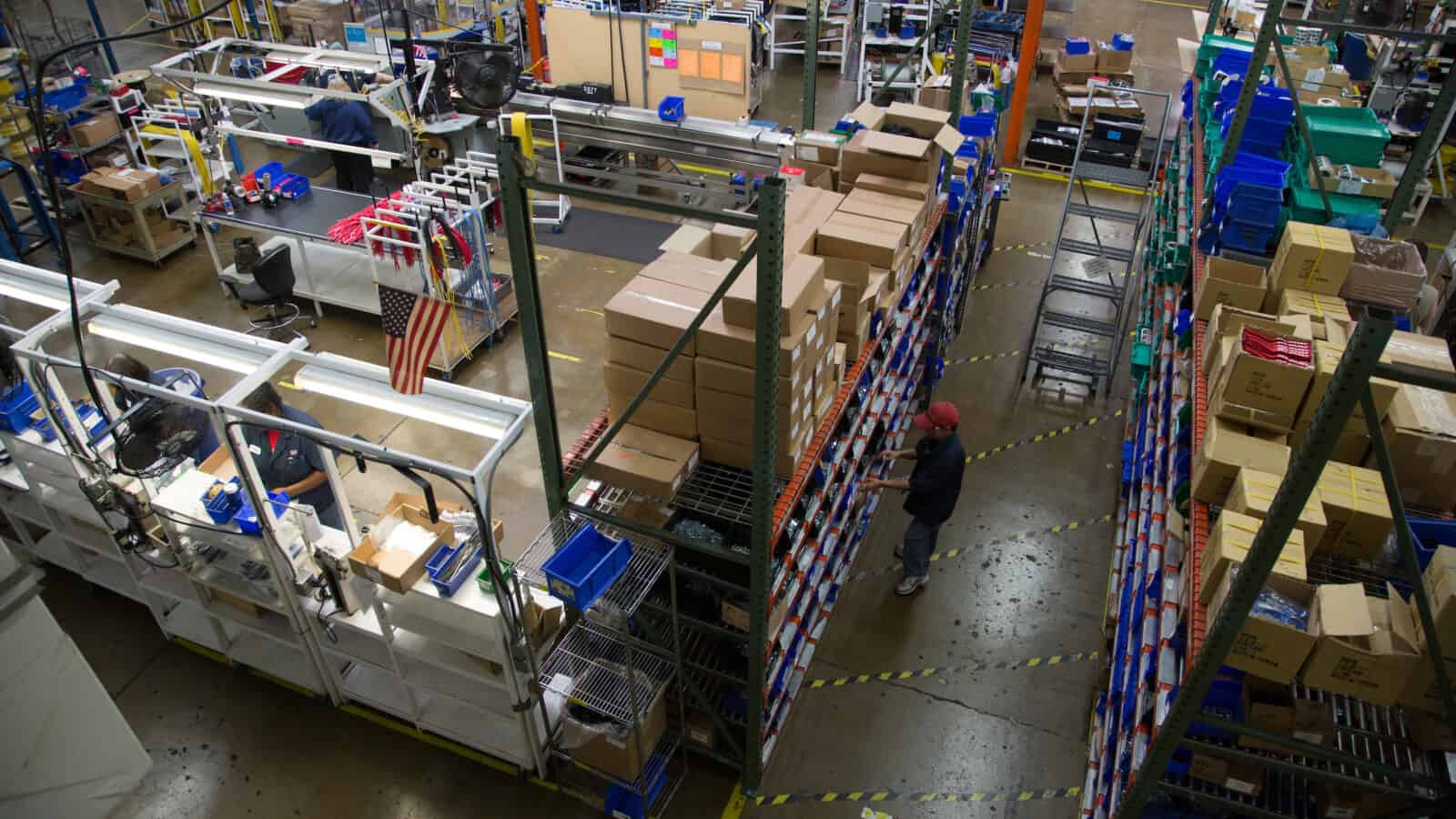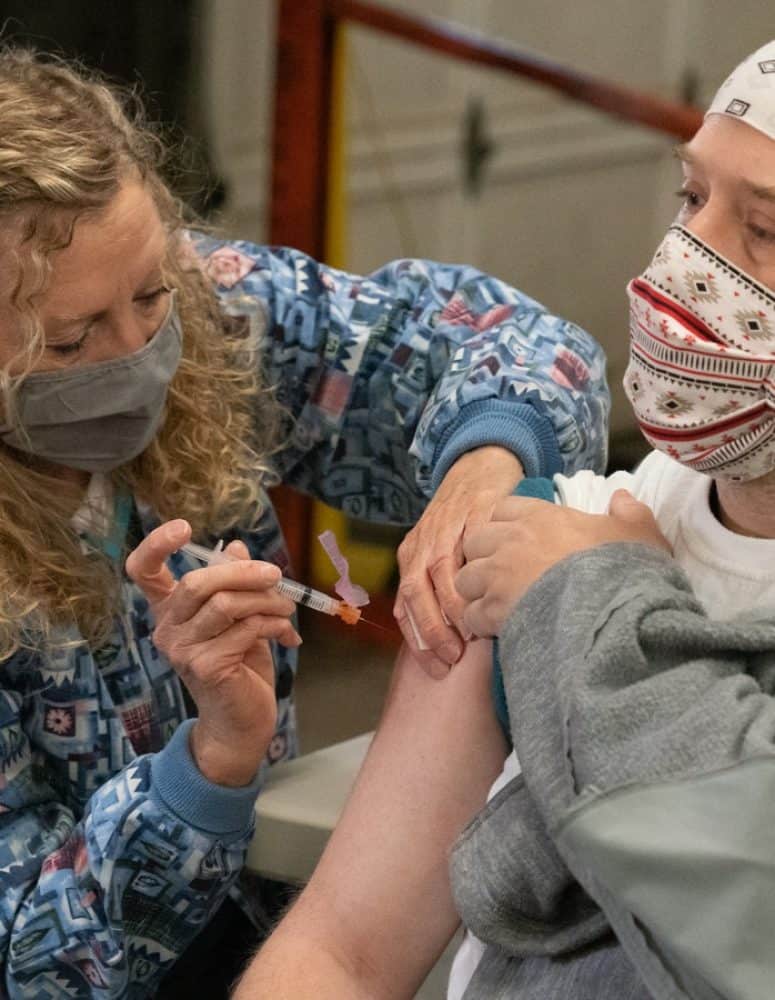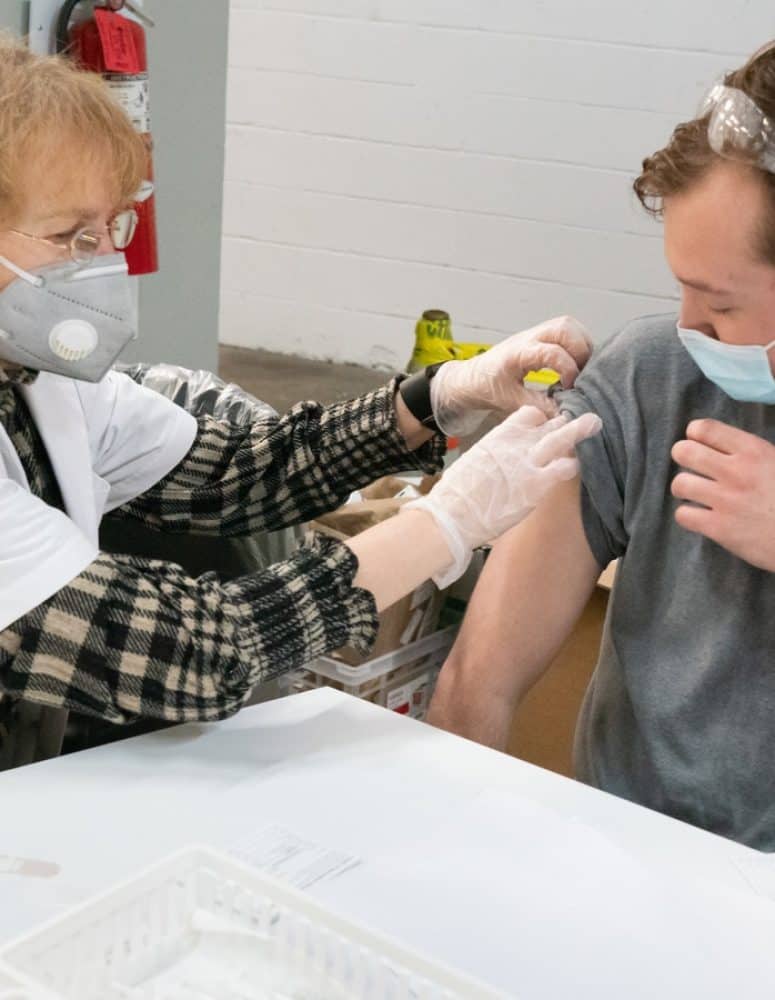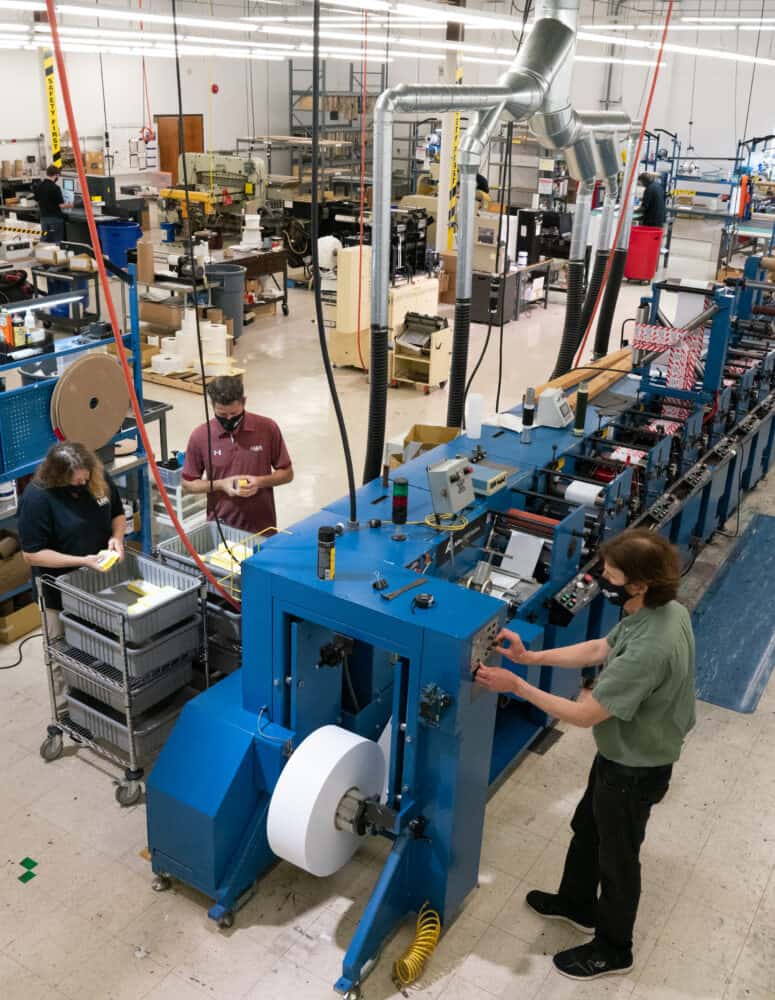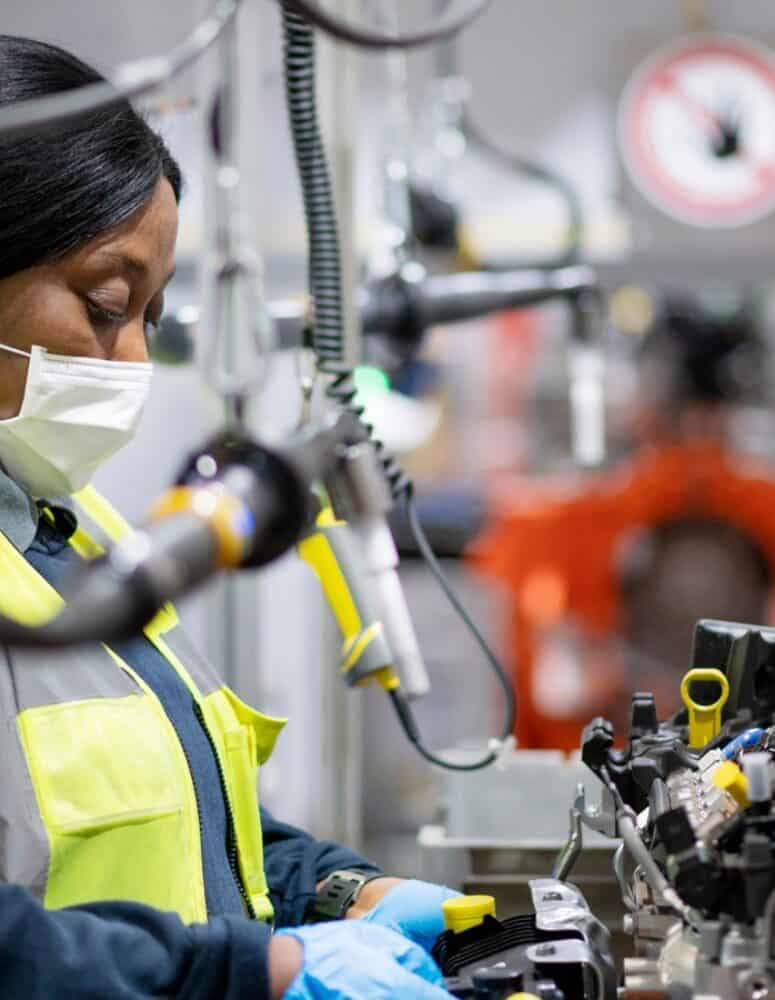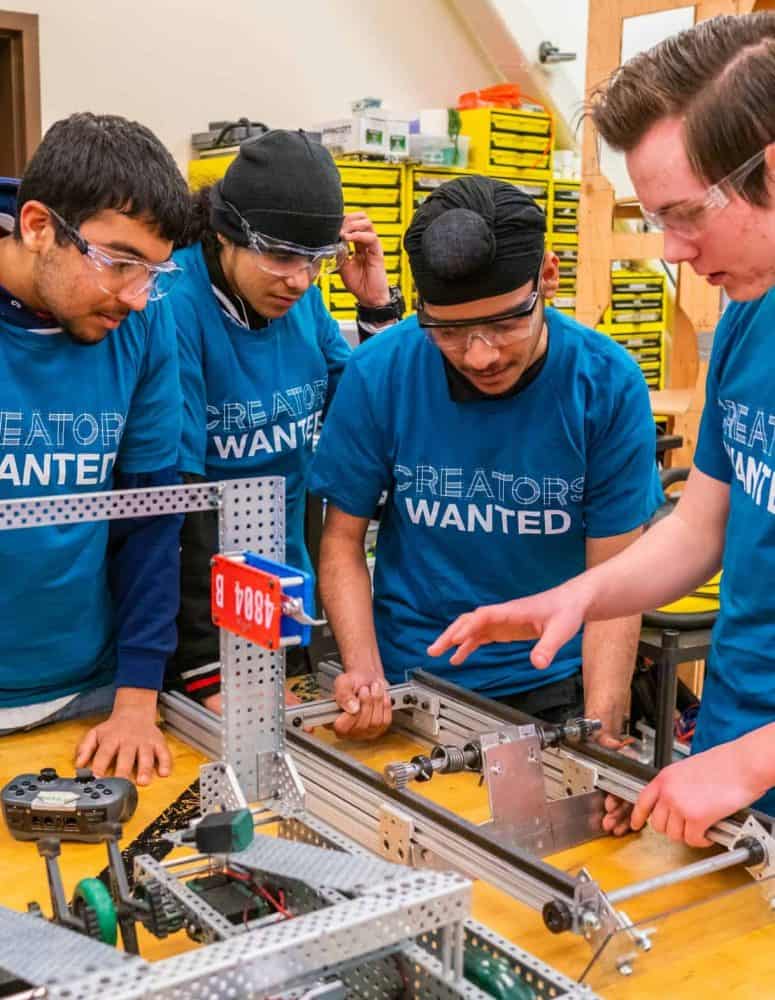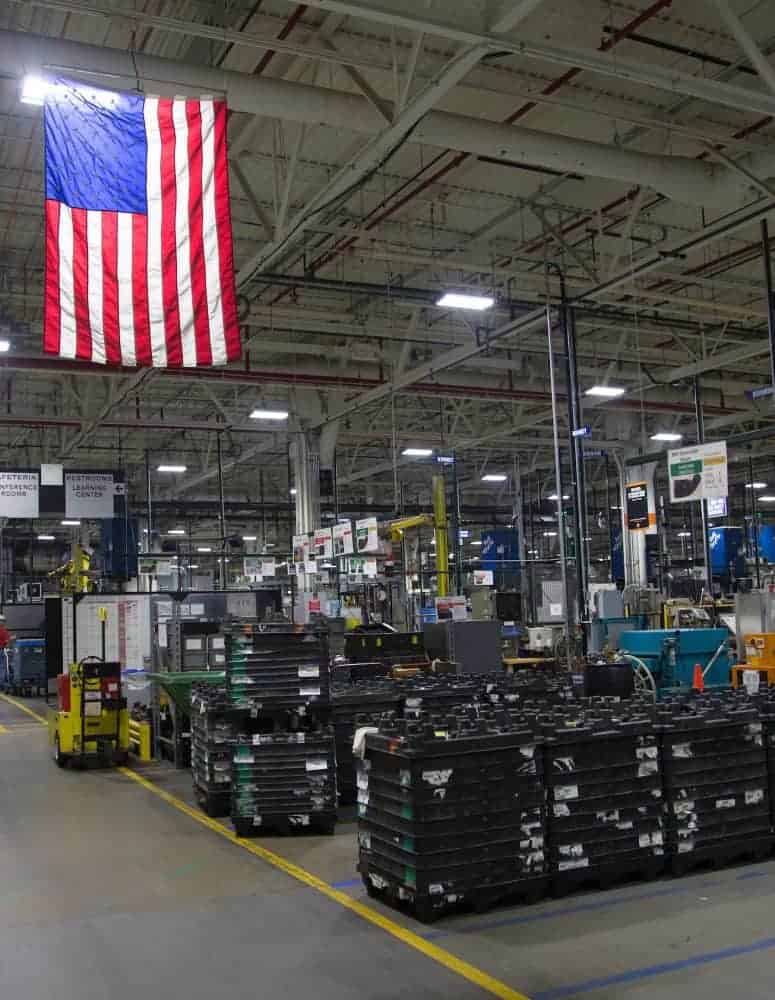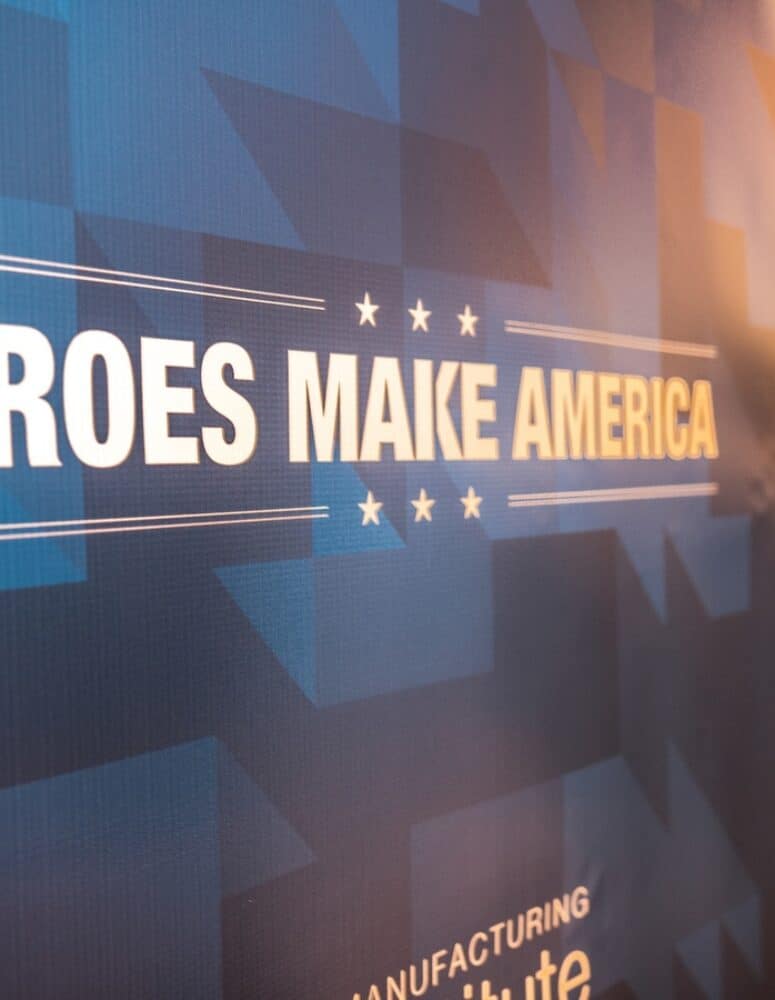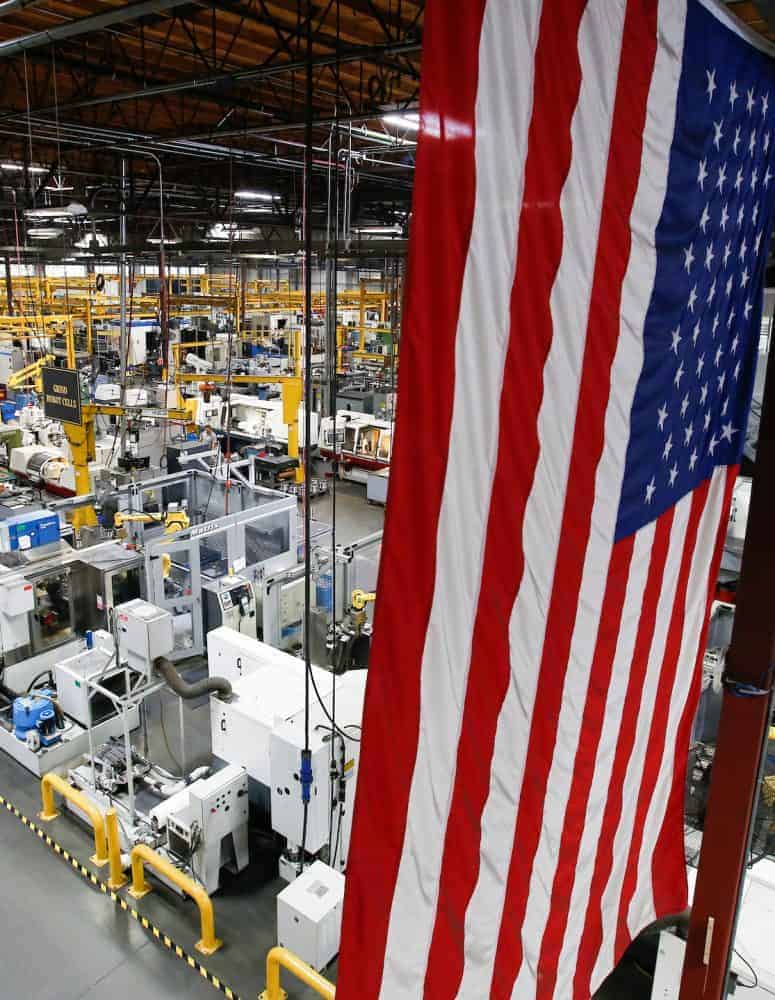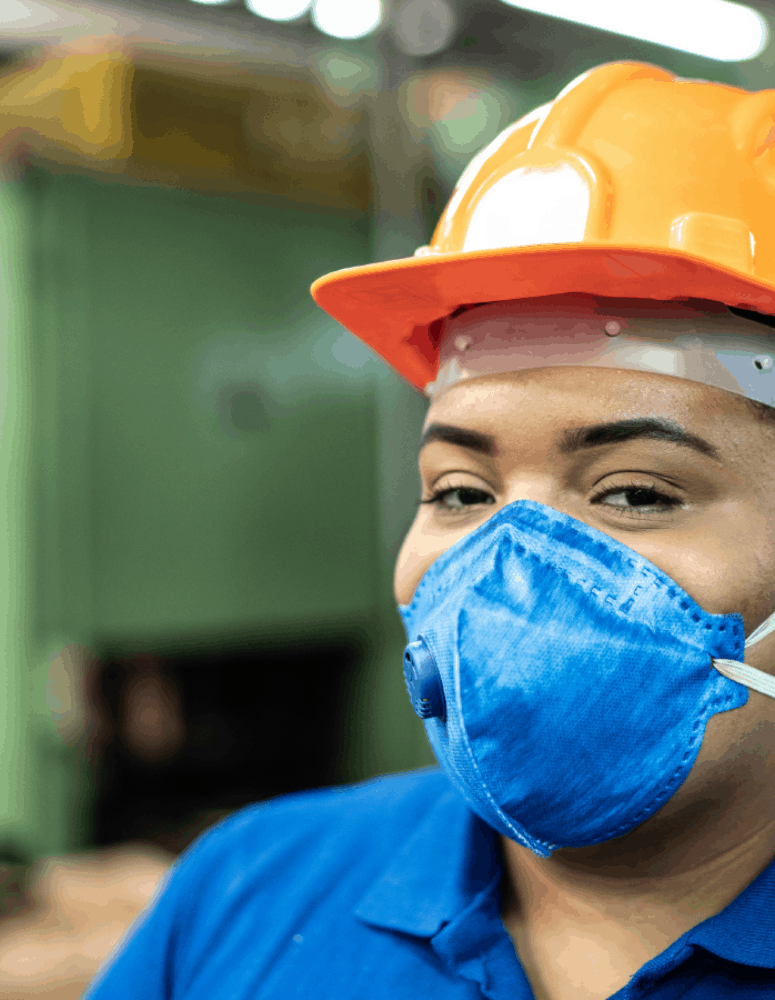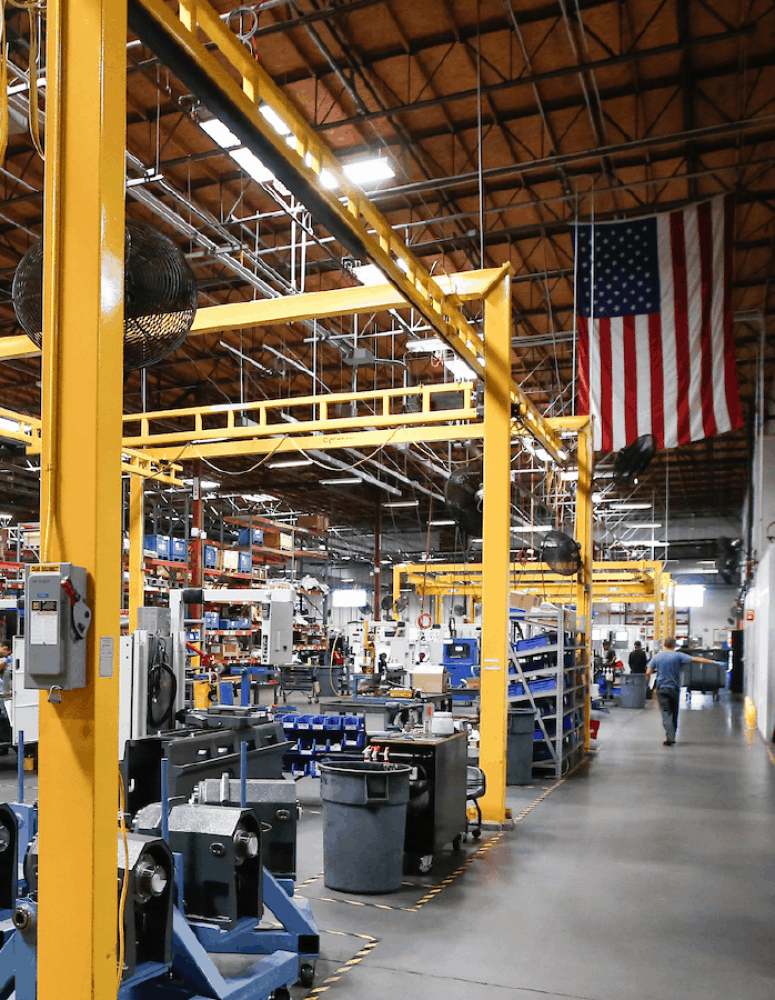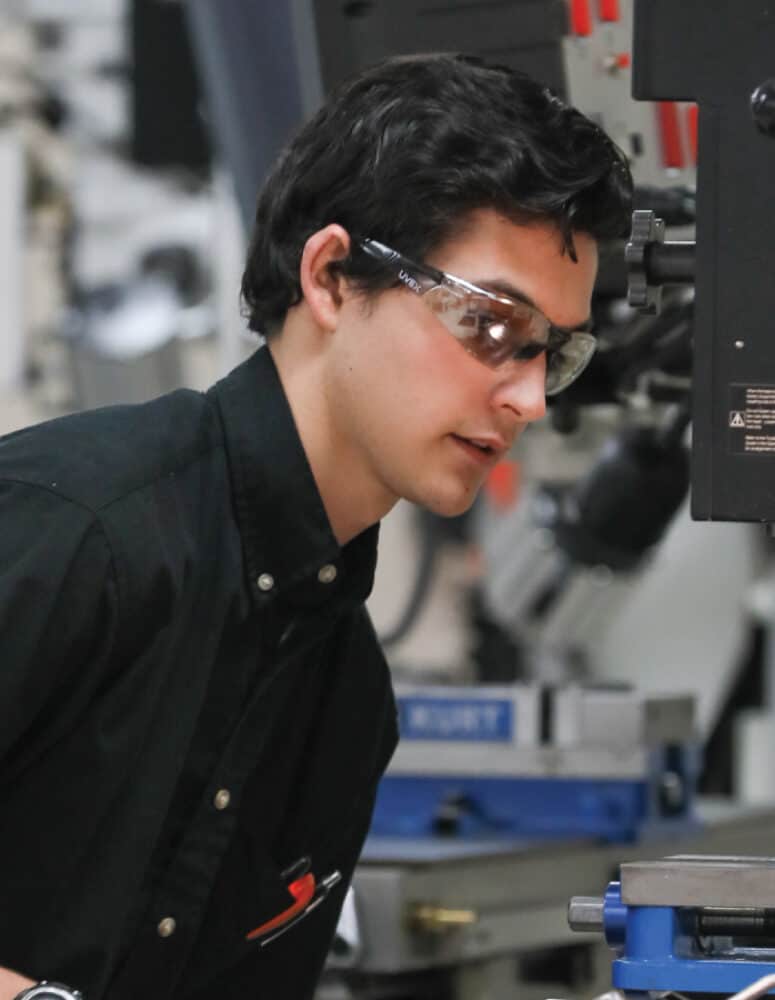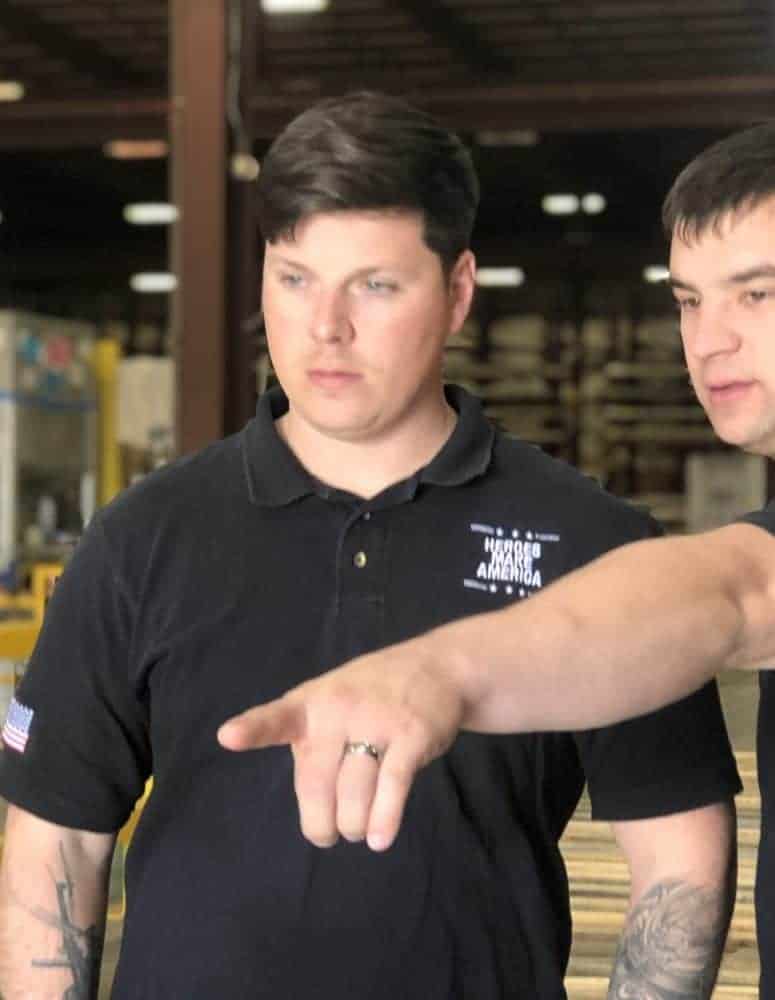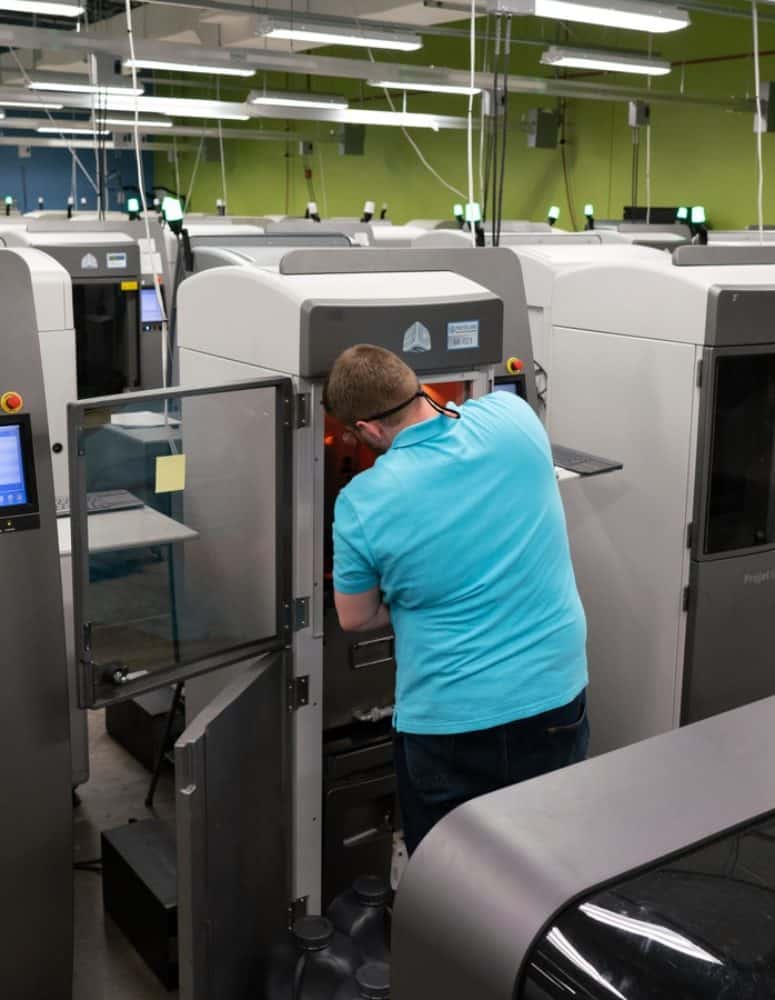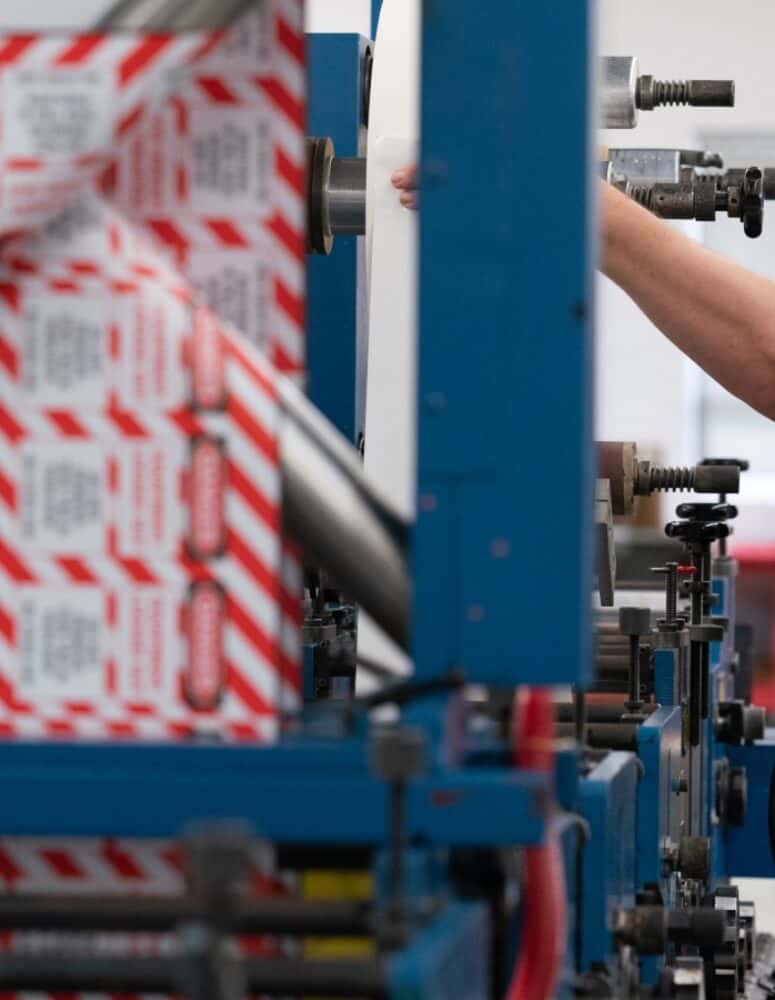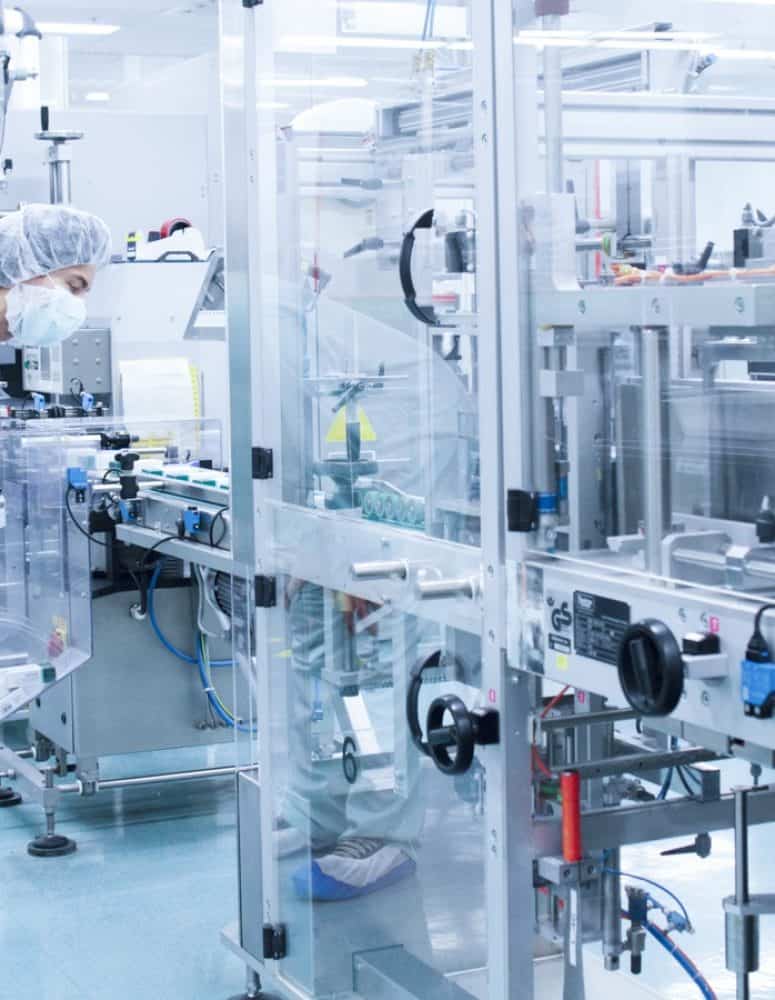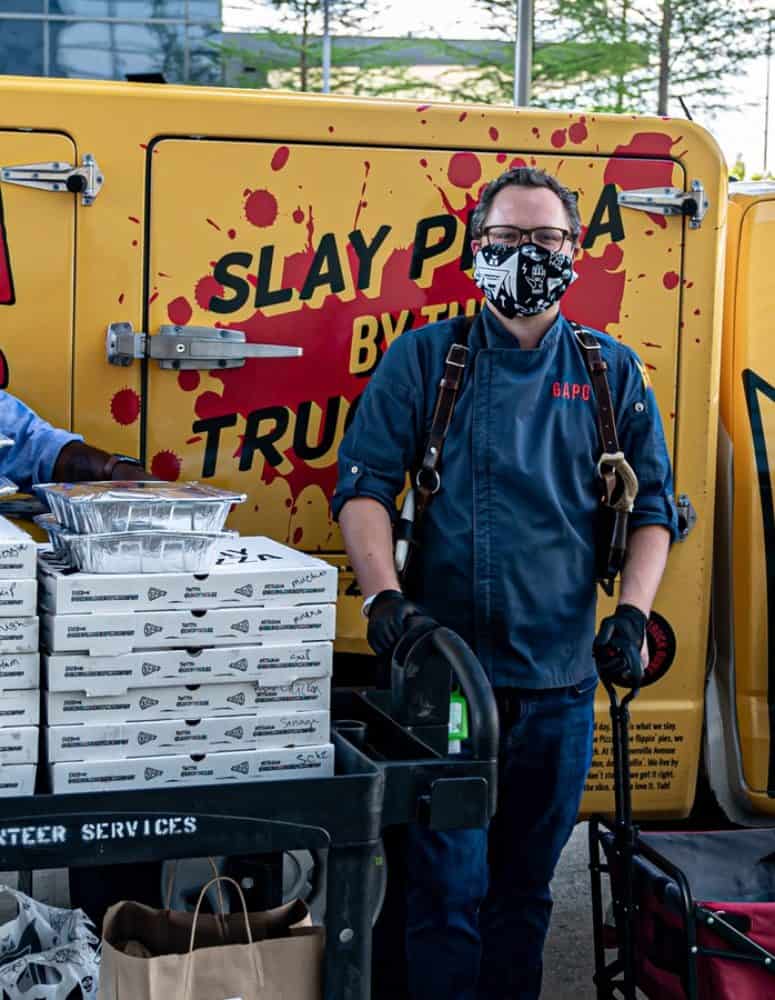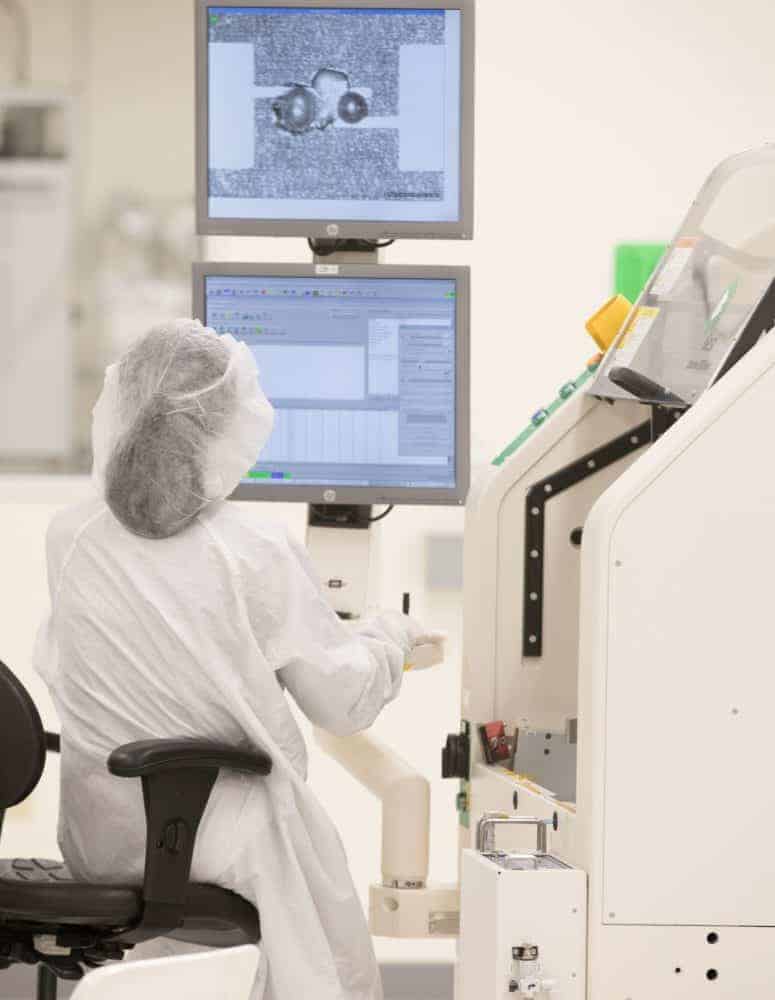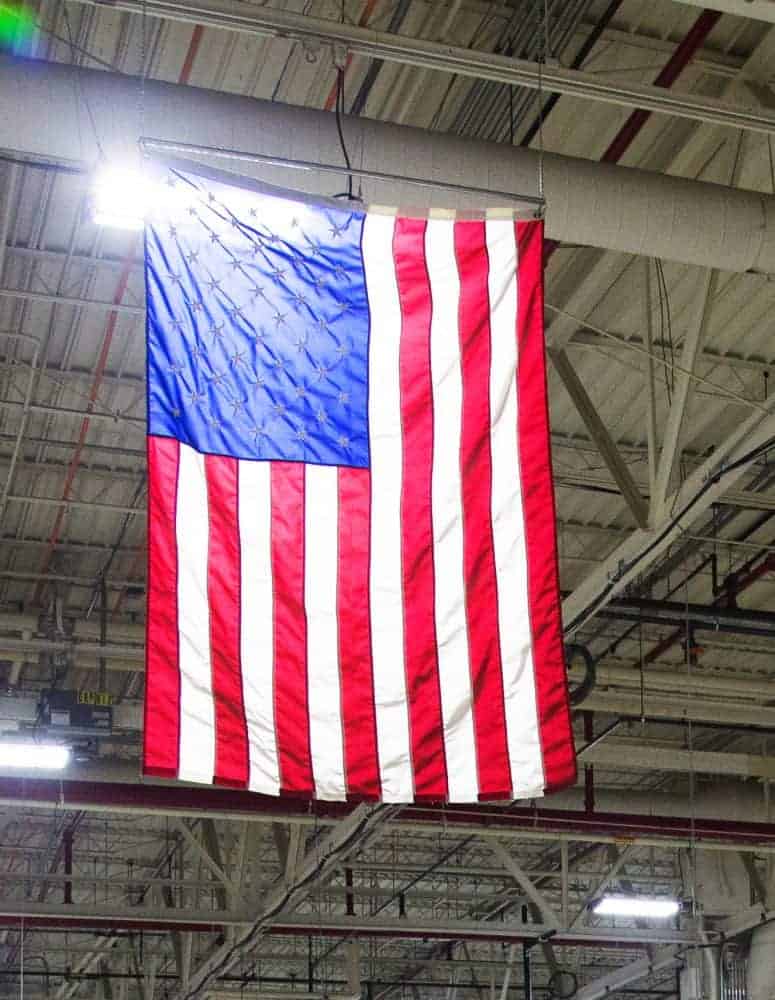A Tour of Manufacturers’ Vaccine Clinics
Get the Latest News
Get involved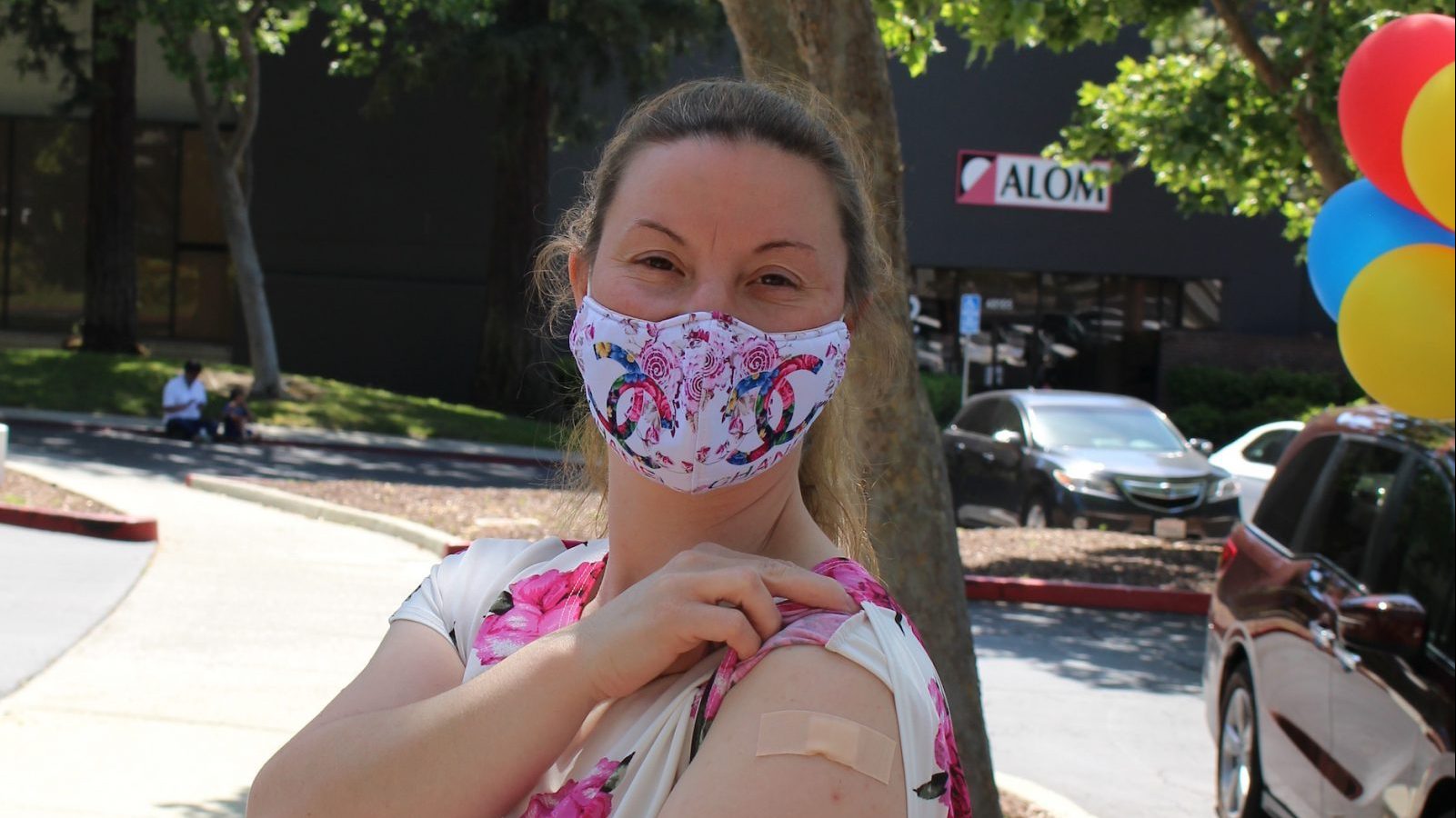
What does it look like when manufacturers get vaccinated? For some people across the country, it was just another day at work.
Hundreds of manufacturers nationwide have hosted vaccination events for their own employees, sometimes including family and community members as well. NAM Director of Photography David Bohrer stopped by a few of these events to capture them, while other companies sent the NAM their own pictures. Here are some of those photos—a visual tour of manufacturers’ efforts to keep America safe and healthy.
Calvert, Alabama: Steel and mining company ArcelorMittal held an on-site vaccine clinic at its plant for team members and the local community. If you look closely, you’ll see that one of these employees is holding a pin from the NAM and The Manufacturing Institute’s Yellow and Red Ribbon initiative—a symbol of vaccination that you can wear to show you’ve done your part.
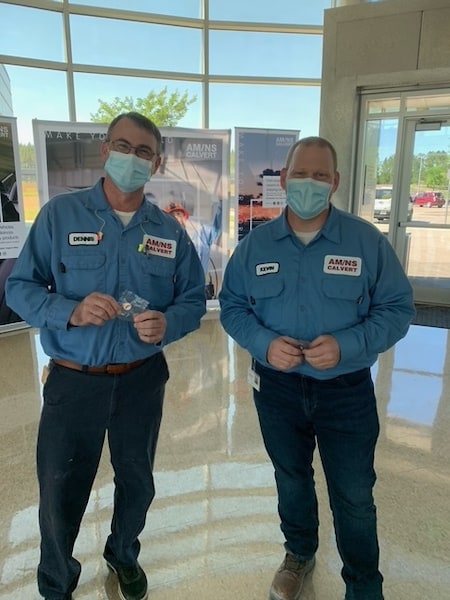
Fremont, California: Below, an employee of ALOM Technologies Corporation, which creates supply chain technology and solutions, gets his shot at the company’s facility. In the background, you can see a poster for This Is Our Shot, the NAM and MI’s effort to help manufacturers across the country get vaccinated.
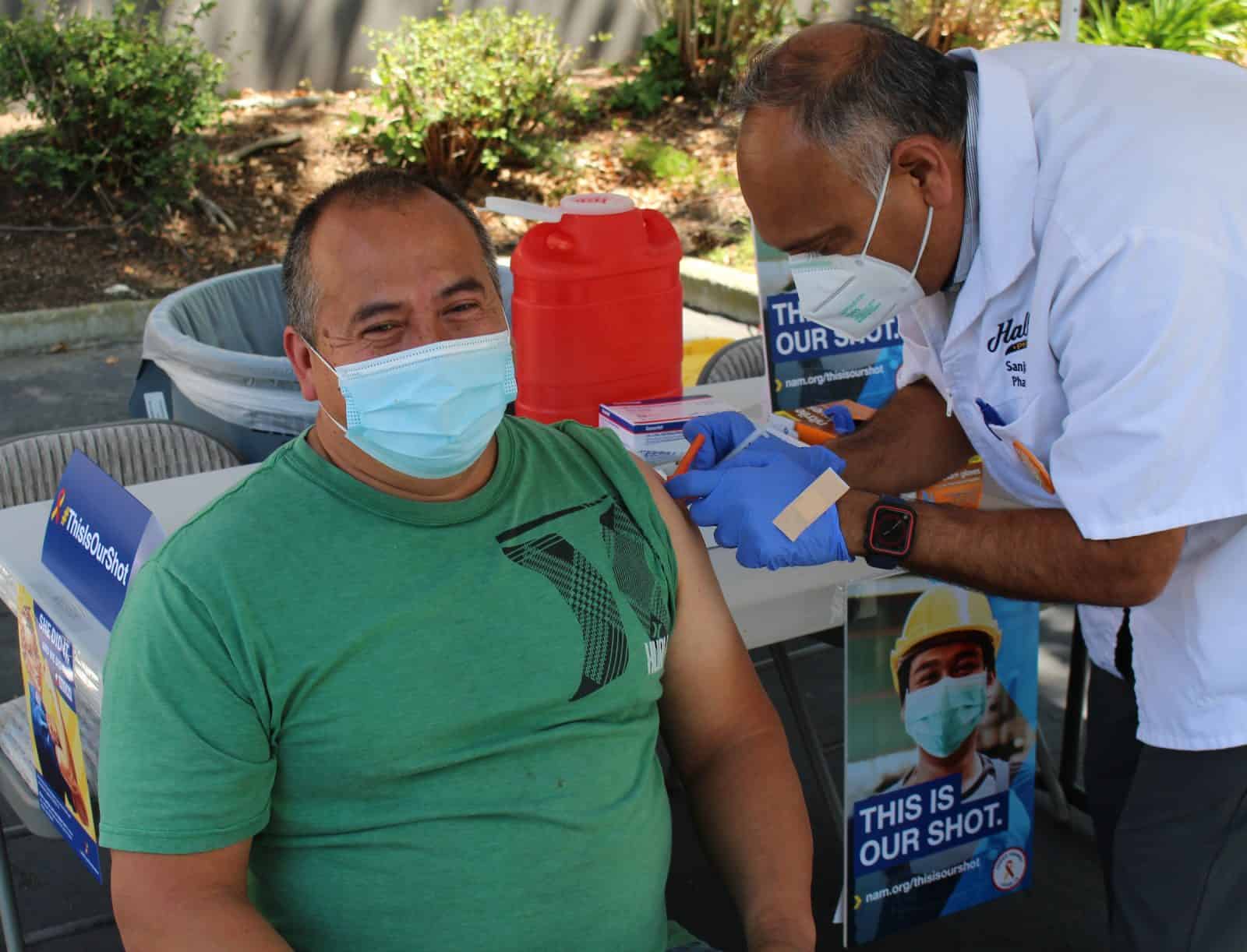
Perryville, Missouri: More than 150 Gilster-Mary Lee Corporation employees were vaccinated at an on-site clinic set up at the company’s request by the local Perry County Health Department.
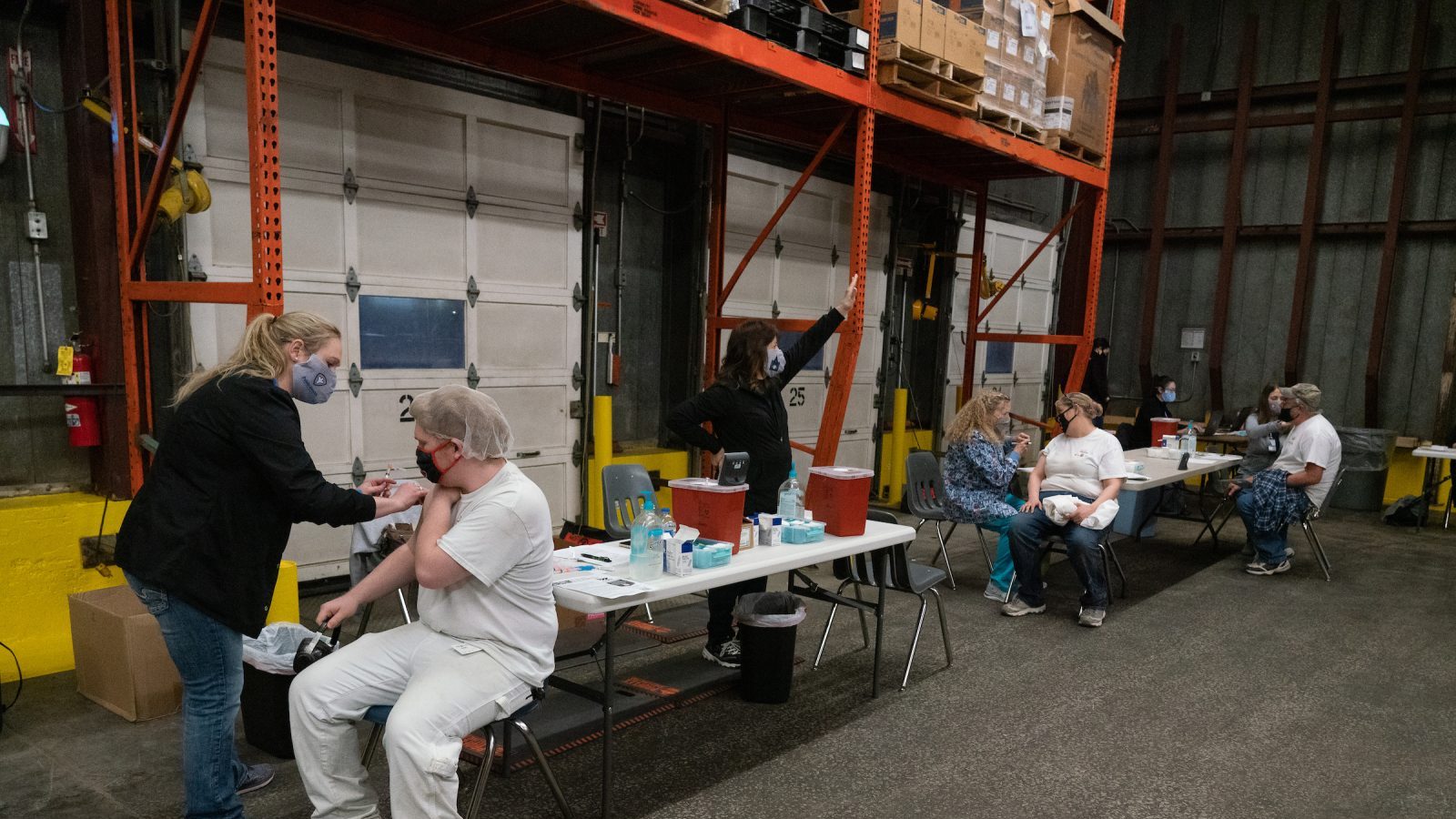
In our interview with Gilster-Mary Lee President and CEO Tom Welge back in April, he told us how the tragic death of his father (and former Gilster-Mary Lee CEO) Don Welge from COVID-19 reinforced the company’s commitment to vaccinations. Read more about the company’s efforts here.
Baltimore, Maryland: Marlin Steel Wire Products led a coalition of 81 manufacturing companies in an effort to get vaccine doses for their workers. In the end, the coalition organized 17 events for more than 3,300 employees.
Here’s a photo from a March event for workers from Marlin Steel, Orlando Products and Arnold Packaging. It was hosted at Orlando’s facility, where a team from Safeway administered the shots.
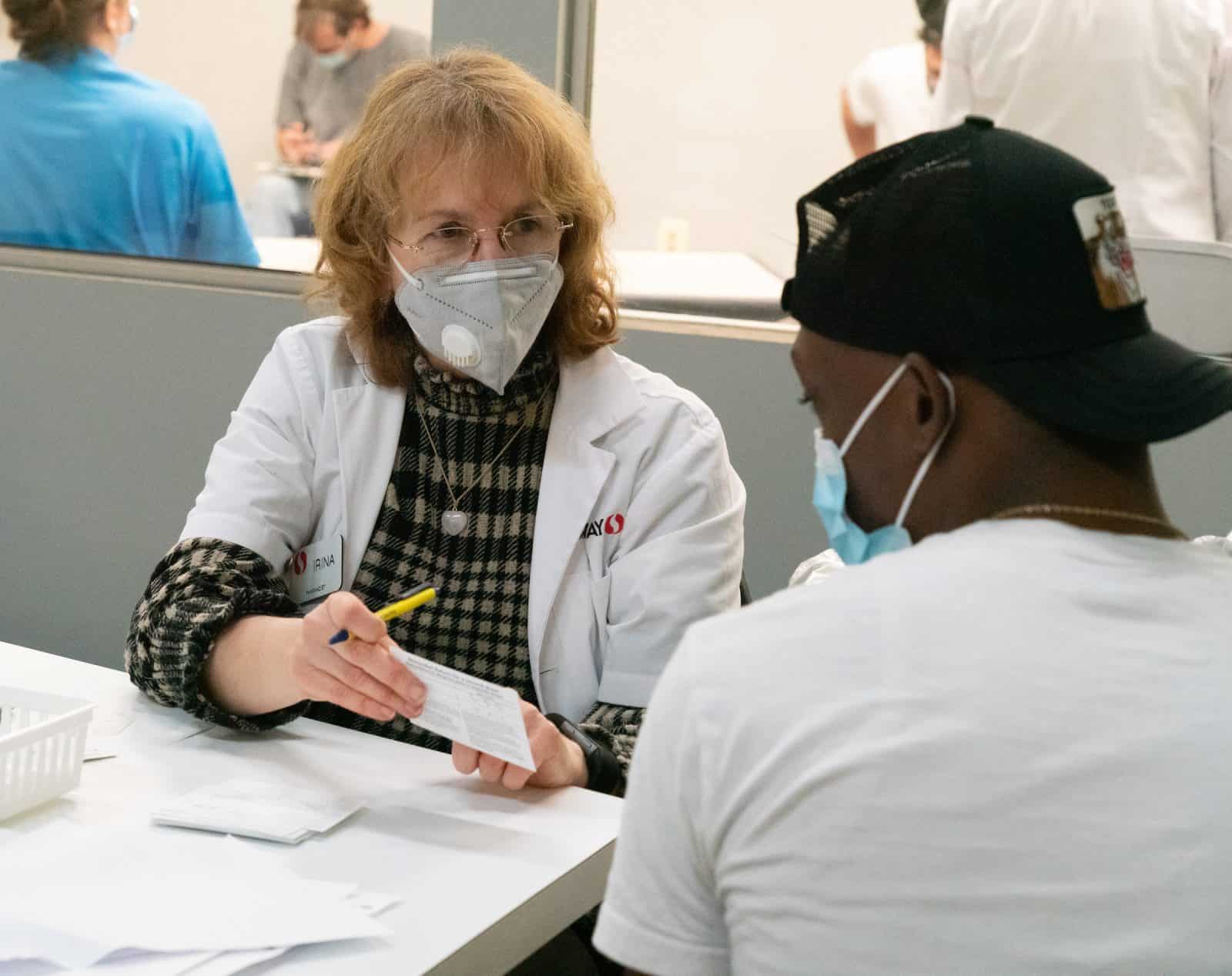
We spoke to Marlin President and Owner Drew Greenblatt back in April about how he organized this effort. Check out the interview here.
Lafayette, Indiana: At Subaru of Indiana, more than 2,900 vaccinations were delivered across eight clinics held in the facility’s lobby. The clinic was open to all on-site personnel, including vendor and contractor representatives, along with associates’ spouses and eligible kids. Recently, the company transitioned to hosting a weekly vaccine clinic at its on-site Health and Wellness Center.
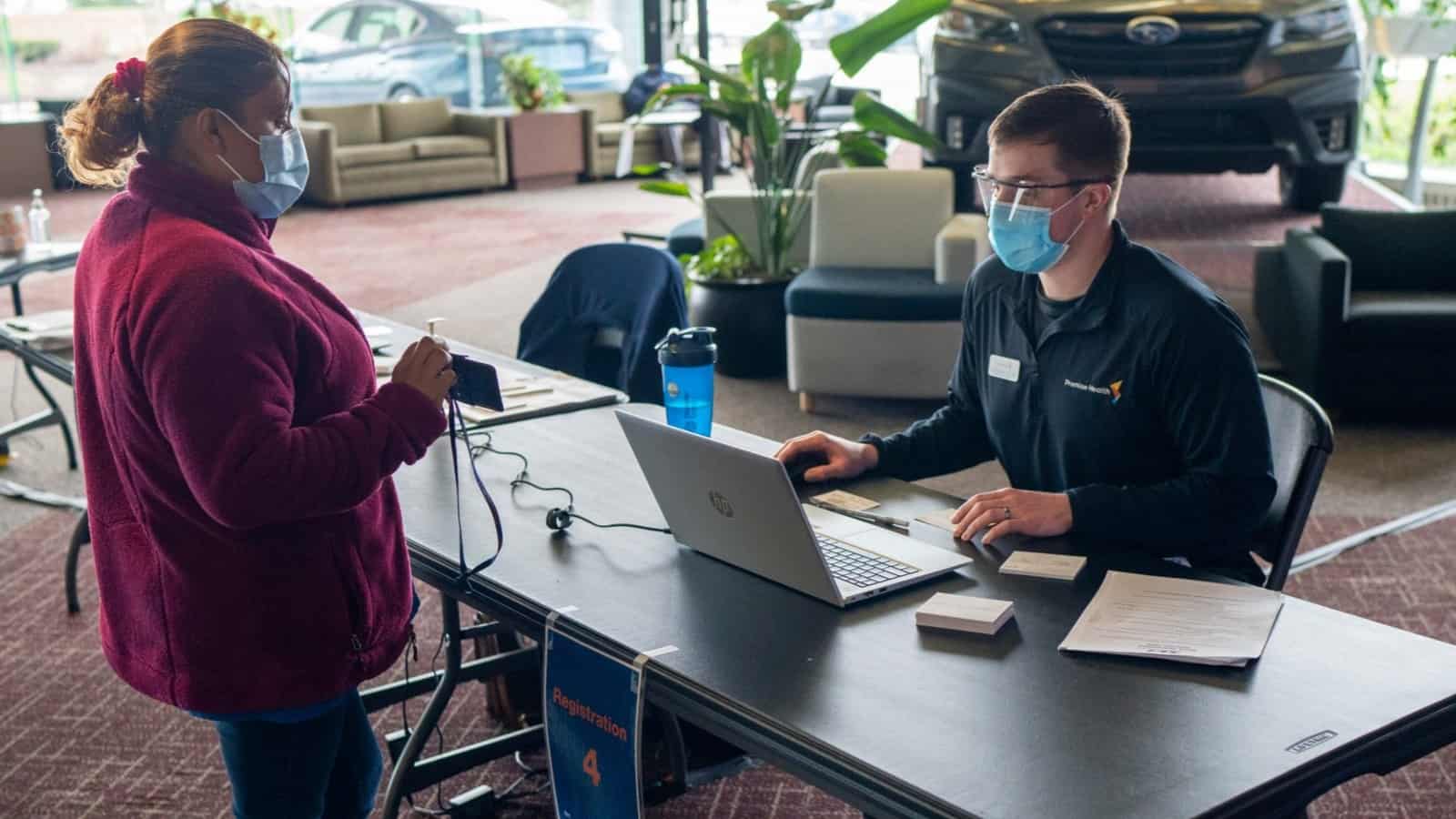
Join in: If you’re a manufacturer looking to encourage vaccinations among your employees or even host an event yourself, check out the many resources available through the NAM and the MI’s This Is Our Shot project. The most recent addition is an “on-site vaccination clinic toolkit” provided by the Department of Health and Human Services. And don’t forget to wear your yellow and red ribbon pin!
Manufacturing Leaders Get a Sneak Peek at Creators Wanted
Get the Latest News
Get Involved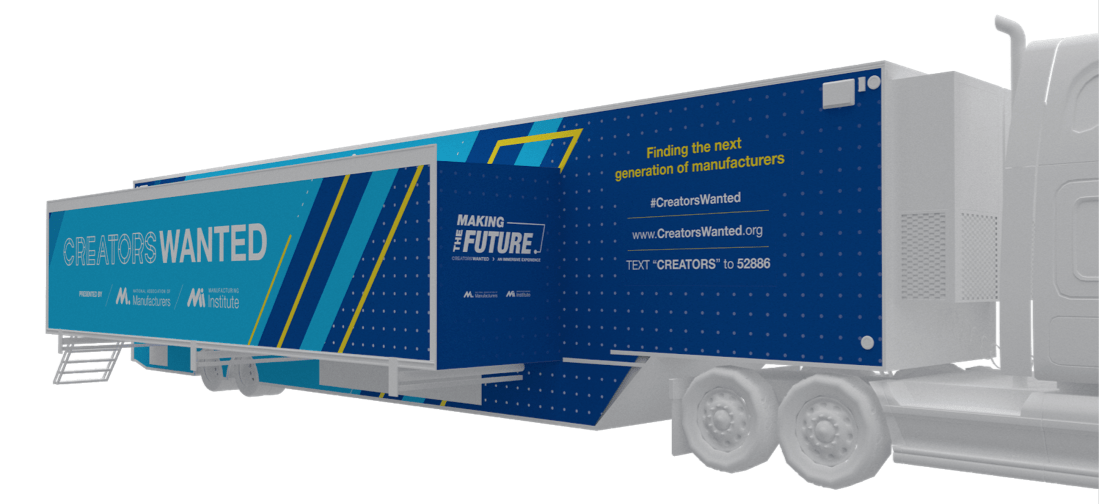
The NAM and The Manufacturing Institute unveiled their Creators Wanted experience last week in Dallas, previewing it for the NAM’s Executive Committee as well as local business leaders, workforce development officials and the media. Visitors got an exclusive look at this “mobile manufacturing experience” that will soon embark on a tour around the country, showing Americans what modern manufacturing is all about.
As NAM President and CEO Jay Timmons said, “Creators Wanted will help a new generation of emerging and displaced workers see themselves in a modern manufacturing career, while also adding to the industry’s talent pipeline by engaging veterans, women and communities of color, all critical to expanding the workforce of tomorrow.”
What they saw: Below, ExxonMobil Senior Vice President Neil Chapman, Celanese Corporation Chairman, CEO and President Lori Ryerkerk, Toyota Executive Vice President of Product Support and Chief Quality Officer Chris Nielsen and Trane Technologies Chairman and CEO (and NAM Board chair and co-chair of the Creators Wanted campaign) Mike Lamach get a first look at this interactive, hands-on experience.
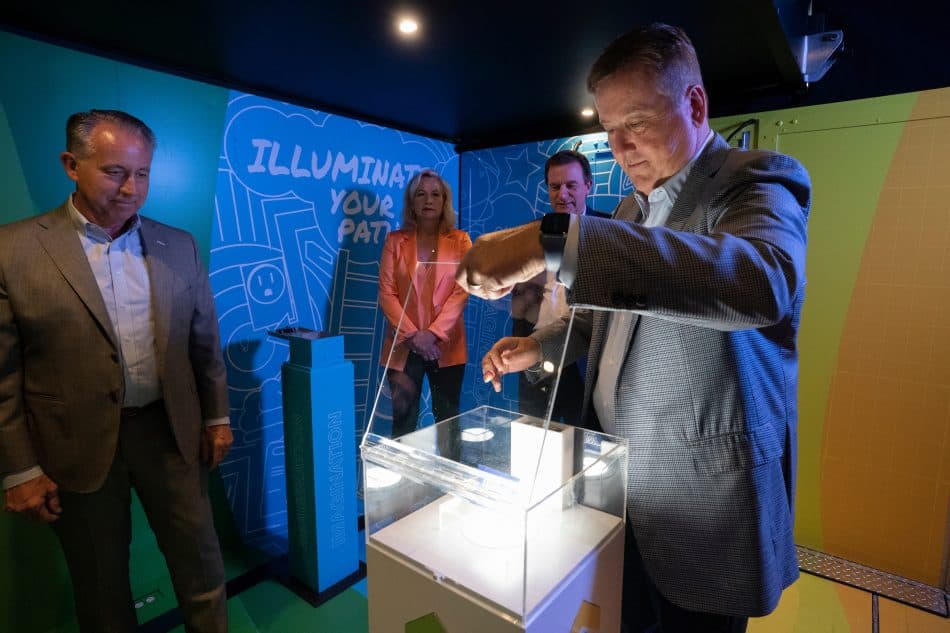
An online choose-your-own-adventure version of the mobile experience will be rolling out this summer to reach students, parental figures, teachers and emerging workers nationwide. Here, MI Executive Director Carolyn Lee previews the “Keys to Success” room, where participants will race to solve riddles that will help reinforce key attributes of manufacturing careers, such as teamwork, problem solving, imagination and communication.
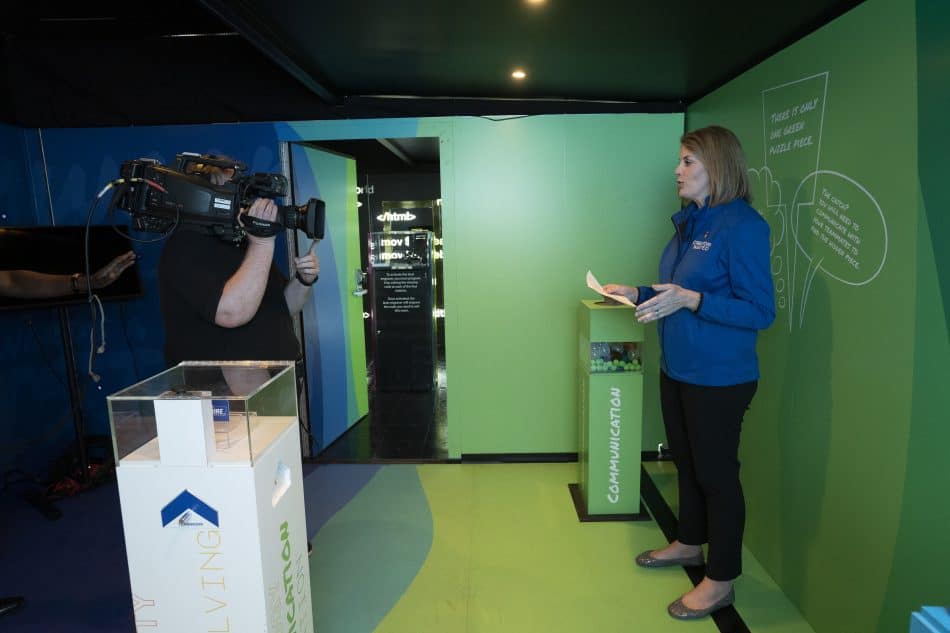
Lee also gave a presentation on Creators Wanted to the visitors. As she said in a statement, “By 2030, manufacturers need to fill more than 4 million jobs—according to research from the MI and Deloitte—but without initiatives like Creators Wanted, more than half of those jobs could go unfilled. This mobile experience will excite audiences across the country, sparking an interest in modern manufacturing so that we can connect emerging and displaced workers with resources that educate and empower.”
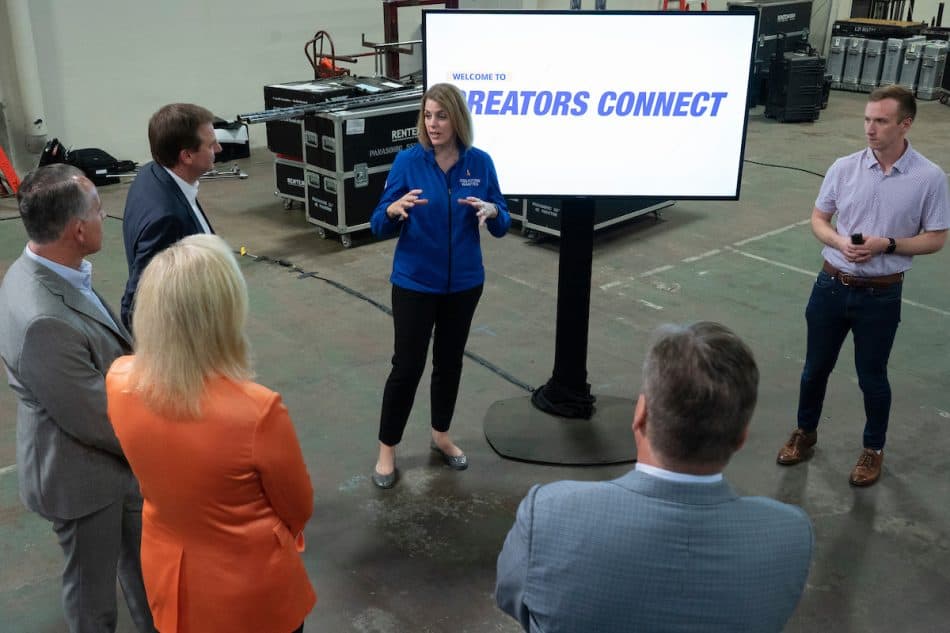
The tour allows you to experience the creativity of manufacturing firsthand and up close. In the gamified experience, participants will work as a team to solve a series of immersive challenges, requiring their full attention to think and compete. As they move through each obstacle, teams will learn more about modern manufacturing careers, the skills required to be successful and how people and technology work together.
We can’t reveal all the surprises, but doesn’t he look excited?
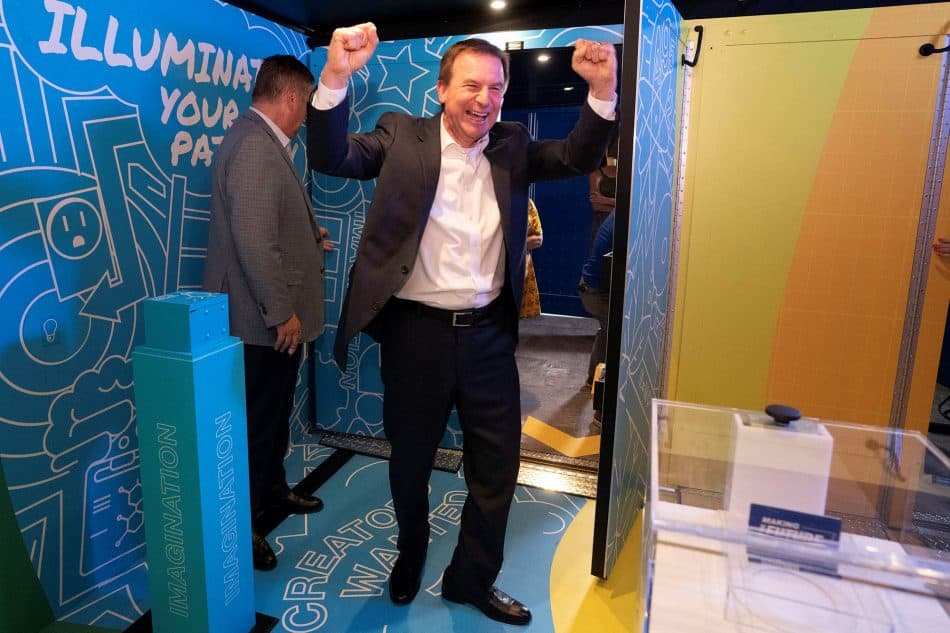
In fact, all of the NAM’s Executive Committee members who toured the exhibition were impressed and amazed by what they saw. Here are some of their reactions:
- “I will admit, I didn’t quite appreciate the opportunity for our industry until I saw the experience in person,” said Chapman. “Seeing is believing in the capacity of this tool to excite the next generation, parents, guardians and teachers about modern manufacturing careers.”
- “It’s clear that Creators Wanted has exactly the message and tools to strengthen our industry’s recruitment for talent. At a time when so many young people seek careers where creativity is valued and prized, we have a chance with this campaign to really drive the best and brightest into our talent pipeline,” said Nielsen.
- “The mobile experience is astounding; it’s unlike anything we’ve done as an industry to reach the next generation and engage emerging and displaced workers. But what makes this campaign worthwhile is that the mobile experience is just one part of a comprehensive plan to create interest and then create opportunity by providing resources to help people launch or grow a career in manufacturing,” said Lamach.
Join in: Last but not least, you too can find out what all the excitement is about. Check out https://creatorswanted.org/ for information about the campaign.
An Army Vet Finds Military Values in Manufacturing
Get the Latest News
Get Involved
Hugo Hinojosa loved being in the military. He served 22 years in the U.S. Army, with time in eight different duty stations. His service gave him the opportunity to get a degree, travel the world, see different places and forge close-knit friendships that he says will last a lifetime. When it came time for him to transition out of the military, he was open to ideas—and during a career skills program briefing at Fort Hood’s Copeland Center, a presentation from Heroes MAKE America captured his attention.
Endless opportunities: After a career spent moving around the globe, Hinojosa was hoping to stay in his home state of Texas for the long term. During the presentation from a representative of Heroes MAKE America, he was struck by the breadth of roles the manufacturing industry offered.
- “When they came out and told me about opportunities and other jobs in the surrounding area, I said, wow, this might be for me,” said Hinojosa. “With the certifications the program offered, you could work anywhere in the industry. I wasn’t limiting myself to a certain, specific job. I could work anywhere, you name it. The opportunities are endless.”
A unique experience: Hinojosa began his time in the program in the midst of the COVID-19 pandemic, which meant that some elements had to be adjusted to fit the logistical reality. But participants still received plenty of engagement: classroom lessons were shifted to a virtual format, and students met with program managers two at a time for a few hours every week. While it required a fair amount of self-direction and motivation, Hinojosa said that the program supported him as he learned at his own pace.
A powerful network: Hinojosa found the networking aspect of the program to be especially valuable once he began looking for work.
- “Every time we would have potential employers in team meetings, I would search them on LinkedIn and connect with them,” said Hinojosa. “I said, I saw you today during class, I’d like to connect. I started building my own network from there.”
The right stuff: The work paid off. Hinojosa received several offers and ended up getting hired by WestRock Company through meetings that were set up by Heroes MAKE America. He began as a member of the company’s management trainee program and was quickly recruited to work as a business partner in the human resources department. He sees his new career as a natural extension of his time as a service member.
- “Everywhere I go, I’m a steward of the Army,” said Hinojosa. “I’m working in a place where the values are in line with what I was brought up with in the military—integrity, respect, accountability and excellence.”
Today, Hinojosa encourages other transitioning service members to see themselves in a manufacturing career—and most importantly, to recognize their own skills.
The last word: “Don’t sell yourself short,” said Hinojosa. “Believe in the skills the military has given you. You’ve been trained and given skills that will pay dividends out here in the manufacturing industry. And the work ethic that’s instilled from day one is going to show.”
How to Talk to Vaccine-Hesitant Workers
Get the Latest News
Sign up here
Now that all American adults are eligible for vaccination and largely have easy access to vaccines, it’s even more important to convince those still on the fence about getting their shots. To help manufacturers convince their hesitating employees, The Manufacturing Institute has partnered, as a part of the “This Is Our Shot” project, with the Center for Public Interest Communications at the University of Florida on a research study about hesitancy and how manufacturers can overcome it.
The big idea: The study aimed to identify strategies that manufacturers can use to increase vaccine confidence among their teams, according to Matt Sheehan and Annie Neimand, managing director and research director, respectively, at the Center. It took a wide-ranging approach, applying social science to this public health problem and looking for evidence-based strategies that employers could put into practice right away.
Why it matters: According to the team, vaccine hesitancy can be driven by a range of factors, including a lack of access to vaccination opportunities, uncertainty about the process of getting inoculated or incorrect or confusing information. Those different motivations can be countered by different approaches, the researchers advise. Understanding where people are coming from makes it easier to give them the support they need.
What we learned: The study arrived at five steps that will help encourage manufacturing workers to get vaccinated:
- Communicate from a place of trust. To be effective, manufacturing leaders should communicate frequently and transparently about vaccination policies and vaccination rates within the facility. Vaccination goals, too, should be focused on the facility.
- Help remove barriers to getting the vaccine. Employers should make it easy to obtain the vaccine and make employees feel supported in their decision to get it. That may mean communicating in languages that their workforce uses, helping employees make vaccination appointments as needed and offering time off for employees to recover if they have significant side effects after the vaccine.
- Highlight trusted messengers. Lots of vaccine skeptics are also skeptical of outsiders, so employers should enlist trusted local authorities, civic leaders and peer influencers to disseminate information.
- Customize tactics to appeal to the community. There is no one-size-fits-all message, and it’s important to reach people who come from different backgrounds and have different ideologies. For some people, it’s important to talk about reaching herd immunity or protecting the most vulnerable in our communities. For others, it’s more effective to talk about the vaccines’ role in protecting their own families and loved ones, or even themselves.
- Address fears at an individual level. Reacting to hesitancy with negativity, or suggesting that all people who are concerned about vaccines are the same, will only increase hesitancy. Instead, listen to individual concerns, and guide people to a useful solution.
Point of emphasis: “It’s important that we listen more than we talk,” said Sheehan. “That’s what’s going to get us to the point where we reach some of these hesitant groups. We need to help solve problems rather than impart information…. If we can listen and hear and alleviate concerns and fix barriers, we’re going to see much more success.”
What’s next: The MI and the Center for Public Interest Communications are preparing to release additional research findings and a new communications guide later this month, to bolster manufacturers’ efforts to get the remainder of their teams and communities vaccinated. Stay up to date on all the latest “This Is Our Shot” project resources at NAM.org/ThisIsOurShot.
How to Talk to Vaccine-Hesitant Workers
Get the Latest News
Sign up here

Now that all American adults are eligible for vaccination and largely have easy access to vaccines, it’s even more important to convince those still on the fence about getting their shots. To help manufacturers convince their hesitating employees, The Manufacturing Institute has partnered, as a part of the “This Is Our Shot” project, with the Center for Public Interest Communications at the University of Florida on a research study about hesitancy and how manufacturers can overcome it.
The big idea: The study aimed to identify strategies that manufacturers can use to increase vaccine confidence among their teams, according to Matt Sheehan and Annie Neimand, managing director and research director, respectively, at the Center. It took a wide-ranging approach, applying social science to this public health problem and looking for evidence-based strategies that employers could put into practice right away.
Why it matters: According to the team, vaccine hesitancy can be driven by a range of factors, including a lack of access to vaccination opportunities, uncertainty about the process of getting inoculated or incorrect or confusing information. Those different motivations can be countered by different approaches, the researchers advise. Understanding where people are coming from makes it easier to give them the support they need.
What we learned: The study arrived at five steps that will help encourage manufacturing workers to get vaccinated:
- Communicate from a place of trust. To be effective, manufacturing leaders should communicate frequently and transparently about vaccination policies and vaccination rates within the facility. Vaccination goals, too, should be focused on the facility.
- Help remove barriers to getting the vaccine. Employers should make it easy to obtain the vaccine and make employees feel supported in their decision to get it. That may mean communicating in languages that their workforce uses, helping employees make vaccination appointments as needed and offering time off for employees to recover if they have significant side effects after the vaccine.
- Highlight trusted messengers. Lots of vaccine skeptics are also skeptical of outsiders, so employers should enlist trusted local authorities, civic leaders and peer influencers to disseminate information.
- Customize tactics to appeal to the community. There is no one-size-fits-all message, and it’s important to reach people who come from different backgrounds and have different ideologies. For some people, it’s important to talk about reaching herd immunity or protecting the most vulnerable in our communities. For others, it’s more effective to talk about the vaccines’ role in protecting their own families and loved ones, or even themselves.
- Address fears at an individual level. Reacting to hesitancy with negativity, or suggesting that all people who are concerned about vaccines are the same, will only increase hesitancy. Instead, listen to individual concerns, and guide people to a useful solution.
Point of emphasis: “It’s important that we listen more than we talk,” said Sheehan. “That’s what’s going to get us to the point where we reach some of these hesitant groups. We need to help solve problems rather than impart information…. If we can listen and hear and alleviate concerns and fix barriers, we’re going to see much more success.”
What’s next: The MI and the Center for Public Interest Communications are preparing to release additional research findings and a new communications guide later this month, to bolster manufacturers’ efforts to get the remainder of their teams and communities vaccinated. Stay up to date on all the latest “This Is Our Shot” project resources at NAM.org/ThisIsOurShot.
Second Chance Hiring Strengthens Manufacturing
Get the Latest News
Sign up here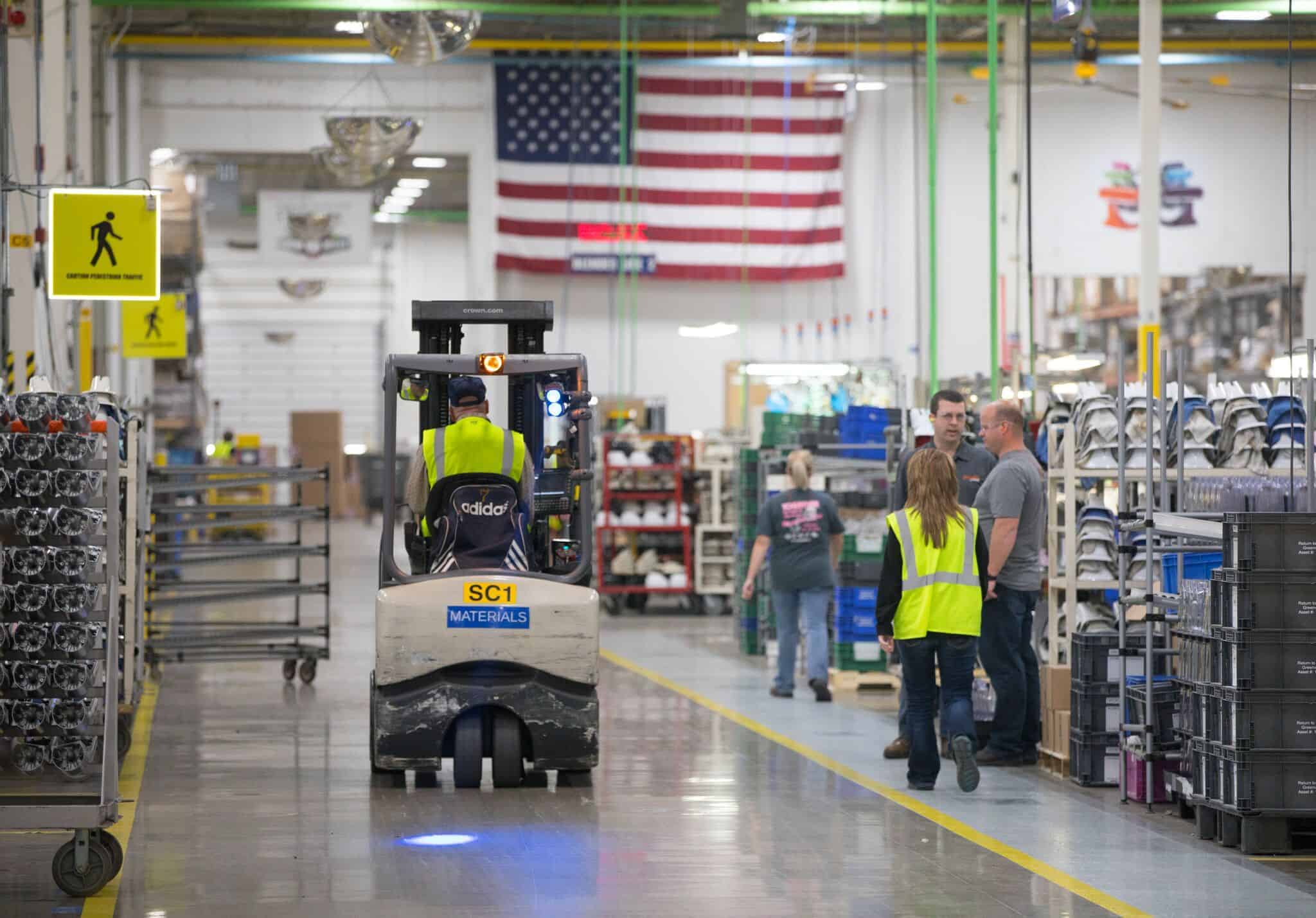
Helping people with criminal records find good jobs is not just the right thing to do, but a way to strengthen the manufacturing industry for years to come. That’s why The Manufacturing Institute—the workforce development and education partner of the NAM—is partnering with Stand Together and the Charles Koch Institute to help manufacturers recruit from this population and fill some of the thousands of job openings within the industry.
Brianna Nuhfer, director of criminal justice for the Stand Together philanthropic community, spoke to us recently about the importance of second chance hiring and the opportunities it offers for manufacturers.
Why it matters: A criminal record is often a significant barrier to employment, preventing people from finding new jobs and building better lives. Not all people with criminal records have been incarcerated, but for those who have been, second chance hiring also significantly increases the success of reentry.
- “The vast majority of incarcerated individuals—over 95% of people who are incarcerated—will be returning to our communities and our neighborhoods,” Nuhfer says. “We want to make sure that their return is as successful as possible, and we know that employment is one of the primary factors that helps people get back on track and avoid recidivism or returning to prison.”
Why it matters for manufacturers: Hiring Americans with criminal records is also important for the success of the manufacturing industry. Right now, manufacturers are facing a significant shortage of skilled workers; in fact, a recent study by Deloitte and the MI suggests that the skills gap could result in 2.1 million unfilled jobs by 2030. Manufacturers need workforce-ready employees, and many people with criminal records fit the bill.
Building a smart workforce: According to Nuhfer, research shows that workers with criminal records often have the lowest turnover rates of all employees. She cites several other key advantages:
- 82% of managers report that the value these workers bring to companies is just as high as—if not higher than—the value that their employees without criminal records provide.
- Many formerly incarcerated people received manufacturing-related training while they were in correctional facilities, preparing them for work in the modern industry.
Building partnerships: The partnership with the MI will increase awareness of second chance hiring opportunities and help manufacturers recruit, train and support these workers.
- “The NAM and The Manufacturing Institute have such an incredible reach across the country, and their leadership is undeniable,” said Nuhfer. “The resources you put out for the field are utilized and noticed—and so your involvement and your commitment to this issue is going to have an incredible ripple effect across the country, opening up thousands of employment opportunities for deserving individuals.”
Creating a culture: For company leaders interested in second chance hiring, Nuhfer has some simple advice: these hiring practices shouldn’t just be a matter of policy, but also a matter of culture. Leaders should demonstrate by example that their companies value smart, talented workers of all backgrounds.
The MI says: “Second chance hiring gives businesses an opportunity to welcome highly motivated, engaged, productive and loyal new team members who may otherwise be overlooked,” said MI Executive Director Carolyn Lee. “This is not only the right thing to do for our businesses, but it’s also the right thing to strengthen our communities.”
The last word: “All of us are more than our choices, good or bad,” said Nuhfer. “None of us wants to be defined by the worst decision we’ve ever made for the rest of our lives.”
To learn more about second chance hiring, register here for an upcoming webinar on June 10.
40 Years in Manufacturing: An Interview with Former CEO Vicki Holt
Get the Latest News
Sign up here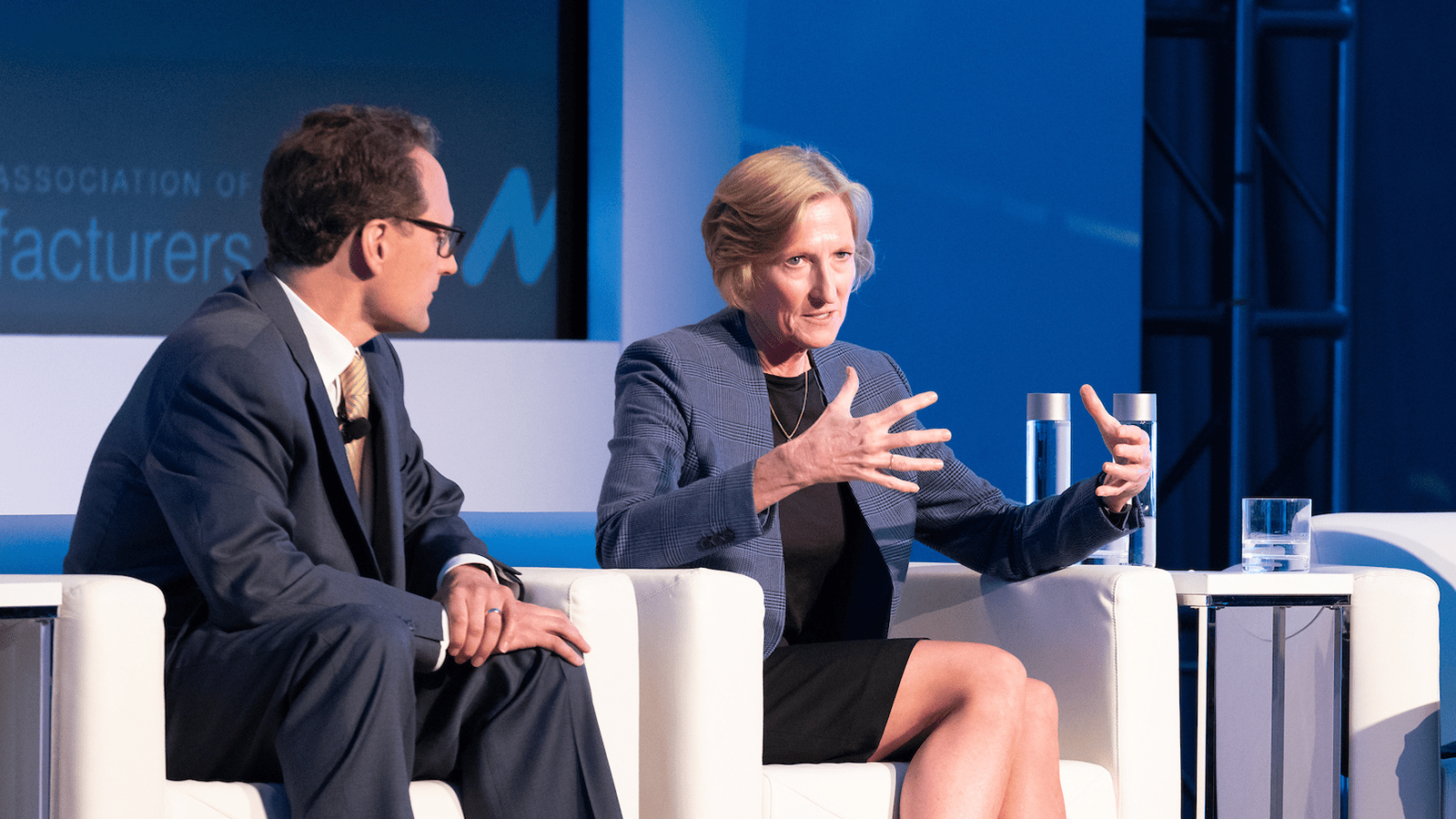
Vicki Holt wants to tell you about digitization. The recently retired CEO of Protolabs, Holt got her start in manufacturing more than 40 years ago and has seen the industry transformed by digital technologies. “By helping manufacturers seize the opportunities of digitization, I believe I am helping them innovate and solve some of the world’s problems,” she explains.
Over the course of her career, Holt led the glass division of PPG, making homes and buildings more energy efficient with solar glazing, then developed sustainable packaging as CEO of Spartech, and from there took charge of digital manufacturing powerhouse Protolabs. We talked to Holt recently about her career, as well as her tenure as the vice chair of the NAM’s Small and Medium-Sized Manufacturers Group, NAM Executive Committee member and as a board member of the NAM’s Manufacturing Leadership Council. Though she has retired from both roles, she remains a key figure in the NAM’s orbit, having recently become a board member at The Manufacturing Institute, the workforce development and education partner of the NAM.
Why the NAM? Holt explains that when she was asked to join the NAM in 2016, she saw it as an opportunity to help manufacturers learn.
- “It was a way for me to get involved and give back, at a time when manufacturing was on the cusp of a new technological revolution,” she says. “I didn’t get involved to influence policy in Washington, but to influence manufacturers themselves.”
By 2017, she had been elected the vice chair of the NAM’s SMM Group, a position she held until her retirement this year. As she notes, the collaboration between the big companies and the smaller ones at the NAM benefits everyone:
- “For example, the big companies were able to dedicate teams to figuring out COVID-19 safety in their factories, and the small and medium-sized companies learned from them. But the big companies also need the smaller ones, because they are essential to supply chains.”
An example of innovation: Holt holds up Protolabs as a prime example of what digitization can do.
- “It used to take companies a long time to innovate, which would stretch out the time for product development. It would take months to make a custom part. Protolabs’ founder broke apart all the things that go into manufacturing a custom injection mold tool and automated the process. What used to take weeks could now be done in a day or two, and all using e-commerce.”
Holt remains an avid watcher of digitization trends, observing that “COVID-19 has accelerated the shift to B-to-B e-commerce throughout the industry, making manufacturers more comfortable connecting to their suppliers digitally.”
Getting manufacturers together: While she was involved with the NAM, Holt also served as a board member of the MLC, which the NAM acquired in 2018 with her encouragement.
- “What I’ve learned through the MLC is that manufacturers are really generous in sharing their learning with other companies,” Holt says. “And that sharing fuels innovation and collaboration.”
- “The MLC complements the NAM,” she adds, “because the NAM is about creating a policy environment that nurtures manufacturing. The MLC is about sharing knowledge about the manufacturing process itself.”
What’s next? Holt is keeping active in retirement. She serves as a board member of several companies—including water heater and treatment maker A.O. Smith Corporation, Waste Management and financial services firm Piper Sandler.
- She is focusing on sustainability in several of these roles and was encouraged to see the Biden administration’s plan for emissions reduction. As she puts it, “If you can unleash manufacturers to innovate, we can reach those targets, even if we don’t have the answers today.”
Holt is also passionate about the mission of the MI:
- “If manufacturers are going to achieve our potential in innovation and digitization, we’ve got to attract people to the industry and show them it’s moved on since the 50s,” she says. “Our frontline employees now solve problems and improve operations in a high-tech environment.”
The last word: Holt says about her time at the NAM, the MLC and the MI, “I’ve just been so impressed with the leaders I’ve met there and their dedication to collaborating and tackling issues like diversity and inclusion. I really appreciate the opportunities afforded to me by being involved in these organizations.”
The Manufacturing Institute Goes to Capitol Hill
Get the Latest News
Sign up here
Manufacturing Institute Executive Director Carolyn Lee testified virtually before the House Committee on Veterans’ Affairs’ Subcommittee on Economic Opportunity yesterday, detailing the MI’s work with transitioning service members during the pandemic. Here are some highlights from her testimony.
COVID-19’s impact: According to Lee, the COVID-19 pandemic made it much more difficult for transitioning service members to access key resources, including training programs, fellowships and internships.
Our work: The MI’s Heroes MAKE America initiative helped develop workarounds for these challenges, Lee testified.
- “At the onset of the pandemic, we collaborated with our education partners to pivot most of our program delivery to virtual platforms or socially distanced environments—within a matter of weeks,” she said. “COVID-19 also accelerated the deployment of fully remote learning for Heroes participants, proving that we can deliver some certifications online.”
- Lee also highlighted the launch of Heroes Connect, which allowed transitioning service members to network virtually with hiring managers from manufacturers across the country.
Heroes’ overall success: The Heroes program has been very successful since its creation only three years ago, Lee noted. “Since its inception in January 2018, Heroes MAKE America has had a placement rate of 92%. Participants have found jobs at more than 250 companies in 39 states.”
- She added, “Notably, 55% of our participants have no post-secondary education, indicating a strong need for support to position them for success in a career after their time in uniform.”
What policymakers can do: Lastly, Lee recommended policy changes that could make military transitions more accessible to service members and their families.
- First, “Congress should change eligibility requirements for Pell grants to allow students to pursue high-quality programs as short as eight weeks.”
- In addition, Lee recommended a separate allocation of funding under the Workforce Innovation and Opportunity Act for the military community. While those funds are currently given directly to states, which place limits on their use, service members may participate in training virtually or in a different location than where they transition. They need the flexibility to receive training or plan careers without worrying about state lines.
The last word: “Veterans are well positioned to succeed in a manufacturing career with skills, talents and training that are highly valued in the industry,” said Lee. “And with more than 700,000 manufacturing jobs open today—and 4 million to fill by 2030—they are in great demand. The Manufacturing Institute is committed to helping today’s American heroes become tomorrow’s manufacturing leaders.”
2.1 Million Manufacturing Jobs Could Go Unfilled by 2030
Get the Latest News
sign up here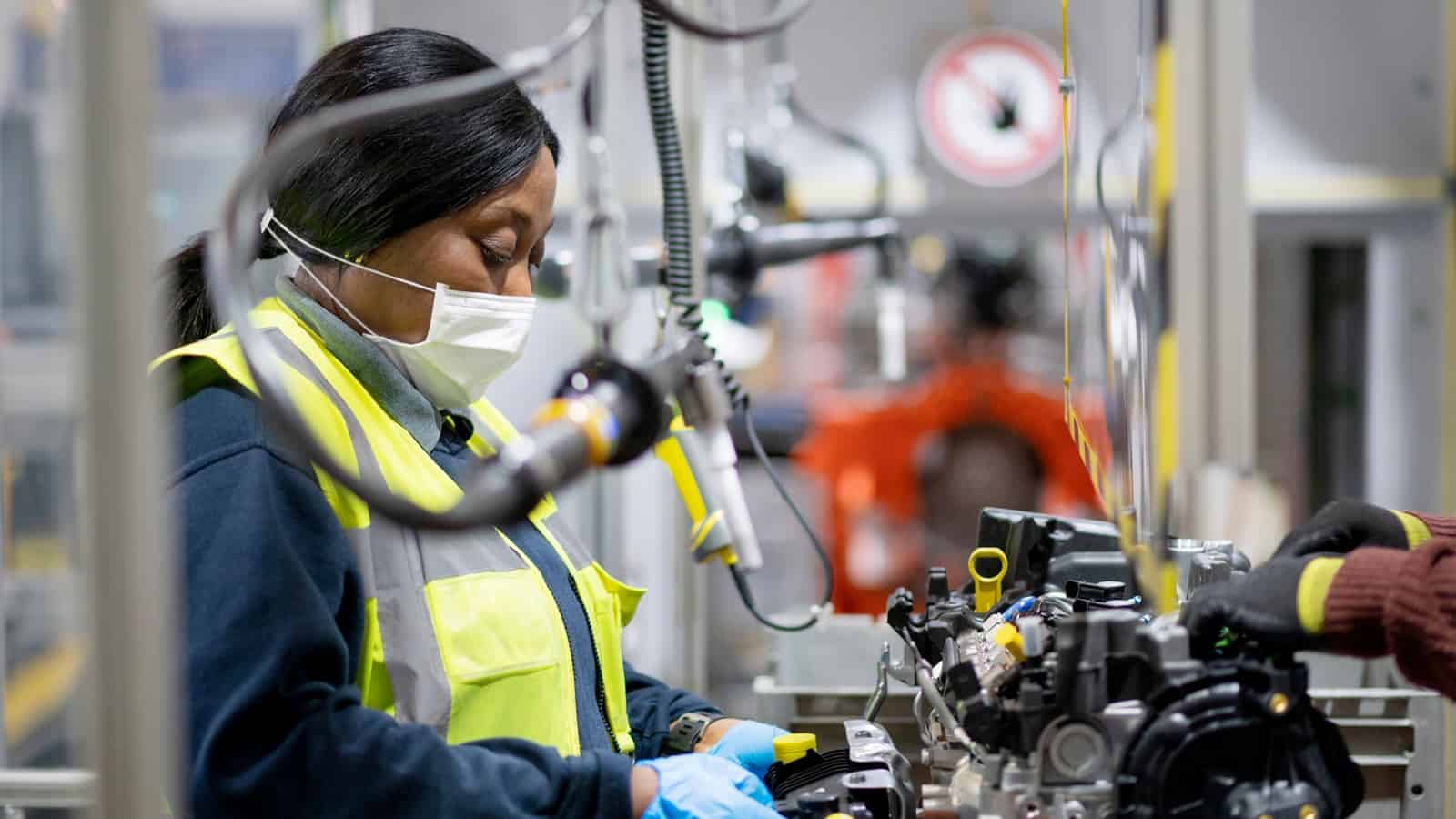
The manufacturing skills gap in the U.S. could result in 2.1 million unfilled jobs by 2030, according to a new study by Deloitte and The Manufacturing Institute, the workforce development and education partner of the NAM. The cost of those missing jobs could potentially total $1 trillion in 2030 alone.
The study’s dramatic findings come from online surveys of more than 800 U.S.-based manufacturing leaders, as well as interviews with executives across the industry and economic analyses. All told, they paint a worrying picture of manufacturing’s labor shortage. The lack of skilled labor was the industry’s major challenge even before the pandemic, according to the NAM’s quarterly outlook surveys—and this new study shows it’s still a major concern today.
The hard data: About 1.4 million U.S. manufacturing jobs were lost during the early days of the pandemic, according to the study, setting back the manufacturing labor force by more than a decade. However, the industry has largely recovered those lost jobs and is now urgently seeking more workers.
- While the manufacturing industry recouped 63% of jobs lost during the pandemic, the remaining 570,000 had not been added back by the end of 2020, despite a near record number of job openings in the sector.
The inside scoop: Manufacturers surveyed reported that finding the right talent is now 36% harder than it was in 2018, even though the unemployment rate has nearly doubled the supply of available workers.
- Executives reported they cannot even fill higher paying entry-level production positions, let alone find and retain skilled workers for specialized roles.
- A long-term challenge: 77% of manufacturers say they will have ongoing difficulties in attracting and retaining workers in 2021 and beyond.
A bright spot: Fortunately, the study found that diversity, equity and inclusion (DEI) initiatives exert a growing influence on workforce trends and can help manufacturers fill these empty jobs. Manufacturers have more work to do to attract larger numbers of women and diverse workers to the industry, and the Institute is leading an industry-wide effort to close the opportunity gap.
Deloitte says: “Given the foundational role the manufacturing sector plays in our nation’s economy, it is deeply concerning that at a time when jobs are in such high demand nationwide, the number of vacant entry-level manufacturing positions continues to grow,” said Paul Wellener, Deloitte vice chairman and U.S. industrial products and construction leader. “Attracting and retaining diverse talent presents both a challenge and solution to bridging the talent gap. To attract a new generation of workers, the industry should work together to change the perception of work in manufacturing and expand and diversify its talent pipeline.”
The Institute says: “Manufacturers are proud to lead efforts to build stronger, more diverse and inclusive workplaces because we are committed to being the solution,” said Carolyn Lee, executive director of the Institute. “As we expand our programs at The Manufacturing Institute, and work with the National Association of Manufacturers on initiatives like our Creators Wanted campaign and tour, we’re making sure that Americans of all backgrounds in all states can find a home in manufacturing and get equipped with the skills to seize these opportunities.”
The NAM and MI Hit the Red Carpet
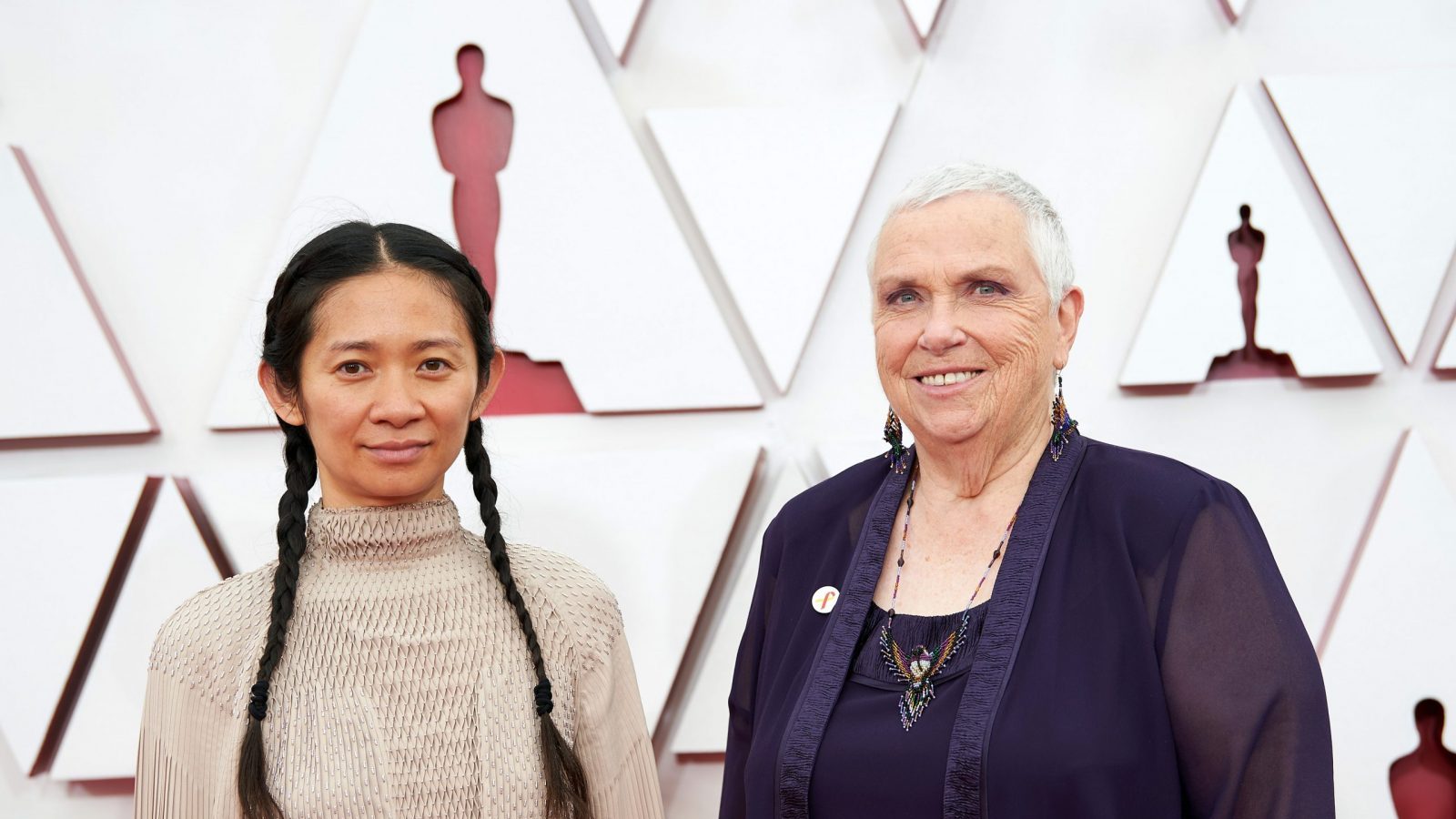
The NAM and The Manufacturing Institute have gone to Hollywood! Last night, two high-profile Oscar attendees, as well as hundreds of people behind the scenes, wore pins from the NAM’s and MI’s Yellow and Red Ribbon project. The pins show that wearers have been vaccinated and are lending public support to the national vaccination effort.
On the red carpet: Charlene Swankie, who appeared in Best Picture winner “Nomadland,” wore her yellow and red ribbon pin on the red carpet and the stage. Meanwhile, director Steven Soderbergh, who served as a producer of the ceremony, also wore this year’s hottest accessory in front of the cameras.
Behind the scenes: Though the red carpet got the attention, more than 500 production staffers behind the scenes were also wearing these pins, thanks to an order made by Shiny Penny Productions.
Why it matters: The on-camera appearance of the pins will help spread their message far and wide, but this was really a twofold success. Those behind the cameras matter just as much, if not more. After all, the people most likely to persuade someone to get vaccinated are friends, family and coworkers—the people you really trust, not the images on the screen.
The NAM says: NAM President and CEO Jay Timmons said, “Getting vaccinated is how we get back to the moments we miss—from gathering with relatives to going to the movies. On more and more shop floors across America, manufacturing team members are sporting yellow and red ribbon pins to show they have been safely vaccinated—just like Sunday night’s production team. The NAM and the MI are proud to help raise awareness and show that getting our shot is the safe and right thing to do. After all, it’s not just about us. It’s about our coworkers, our loved ones, our communities, our country and our future.”
Get involved: You can learn more about the Yellow and Red Ribbon project, and purchase some pins of your own, here. And check out the NAM’s and MI’s This Is Our Shot project, of which the yellow and red ribbons are just one part. You will find resources to help you talk to your employees and communities about the importance of getting vaccinated and contributing to our national effort to end the pandemic.
